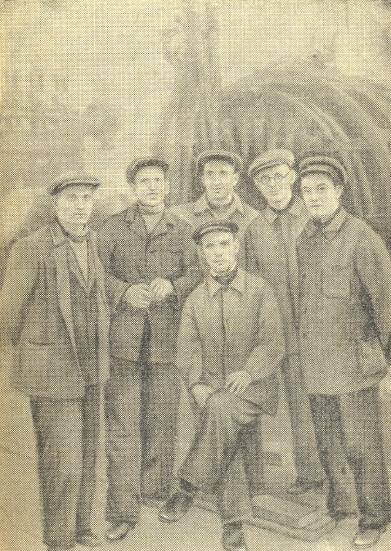
When contacting us by e-mail, correspondents are asked to include their name and full postal address and, when providing information, to quote exact book and magazine sources. The word ‘chess’ needs to appear in the subject-line or in the message itself.
| First column | << previous | Archives [23] | next >> | Current column |

John Hilbert (Amherst, NY, USA) submits a paragraph about Zukertort by ‘Mars’ (G.A. MacDonnell) in the Illustrated Sporting and Dramatic News, 26 June 1880:
‘“Zed” is endowed with a strong memory and a lively imagination; indeed, he can remember facts that never occurred, and paint scenes from nature that have no existence but in his mind’s eye. Hitherto known as a dull and pompous inditer of mystic paragraphs, he has lately essayed to be witty and satirical. I am very glad of this change. I congratulate him upon it. But he does not seem to be at home in this new line, and I fear he will require many lessons before he reaches efficiency in it. “Zed”, your dagger may be sharp, but I don’t think you know how or when to use it. You should use the point of your weapon, if it has any, and you should not strike out in a club room before your host and the assembled guests. “Zed”, you are a puzzle to me – you are an anomaly in the world of chess literature. I am strongly of the opinion that you ought to be abolished. You are, as Kent says in King Lear, an unnecessary letter. And why unnecessary? A commentator replies, Because S answers all the purposes of Z. Yes, and answers them a great deal better. In chess we have a W.S. who for all chess purposes is worth more than double you Zed!’
The unresolved Terrazas mystery arises from a statement by Frank Mur on page 227 of his English translation of A. Alekhine Agony of a Chess Genius by P. Morán (Jefferson, 1989) regarding one of Alekhine’s games at Sabadell, 1945:
‘Alekhine’s victim was 11 years old. Years later he wrote:
“I only recall that the imposing figure of an Alekhine made one play with a deep reverential awe, especially at that age.” – Filiberto Terrazas to Frank X. Mur, letter dated 19 January 1979.’
However, the photographs of Terrazas from Miquel Artigas in C.N.s 4008 and 4015 suggested that Alekhine’s opponent was the adult local player Teodoro Terrazas:
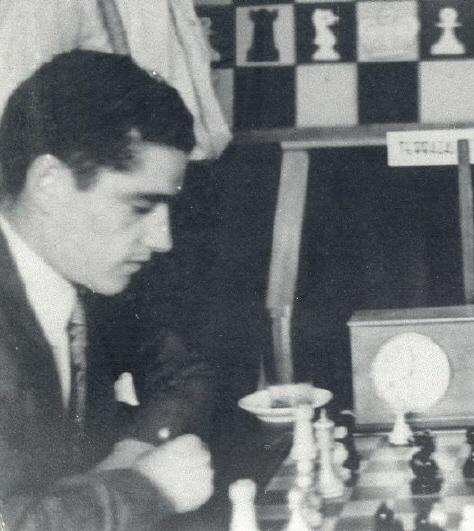
Terrazas at Sabadell, 1945, playing against Ros
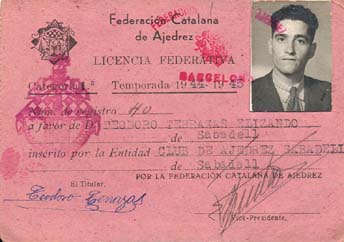
Mr Artigas now reports:
‘I have been doing some research in the Arxiu històric de Sabadell, where the local newspaper Sabadell of the time is available. Unfortunately there are only two pieces of information about the tournament preliminaries and no further news about the event, crosstable or scores.
However, the newspaper presented Terrazas as a local player, and in my opinion it is now clear that it was Teodoro Terrazas Elizando, and not Filiberto Terrazas as stated by Frank X. Mur.
Surprisingly, the report also said that the player Glotas [?] defeated Alekhine in Gijón, whereas, according to Morán and Skinner/Verhoeven, Alekhine defeated Clotas and lost only against Medina and Bonet. This would seem to be a mistake by the journalist.’
The full text of the report, on page 2 of Sabadell, 27 July 1945, is given below:
‘AJEDREZ
de la Obra Sindical EDUCACION Y DESCANSOEl Dr. Alekine [sic], campeón mundial de ajedrez y el Maestro Lupi, campeón de Portugal, en el IV Torneo de Maestros de la Fiesta Mayor
Por primera vez en la historia deportiva local, será escenario Sabadell de una Competición internacional de Ajedrez, que por la calidad y número de participantes inscritos, promete resultar la más importante prueba ajedrecística, celebrada en España desde largos tiempos.
En dicho Torneo, nuestros jugadores nacionales tendrá [sic] nuevamente ocasión de aquilatar sus fuerzas ante el actual campeón mundial Alekine [sic] a quien lograron vencer brillantemente en Gijón, el campeón de España Medina, y el asturiano Glotas [sic].
Los jugadores locales Sres. Dr. Mena de la Torre, Ros y Terrazas, inscritos también para el mismo, se preparan activamente para dar digna réplica a sus adversarios de tan magna competición y confiamos que su entusiasmo aumentando sus posibilidades, les llevará al desempeño de un tan brillante papel como el del año anterior.’
C.N. 4387 asked what happened to Pablo Morán’s library and archives after his death in 1995. Mr Miquel Artigas writes:
‘On page 7 of issue 43 of the Spanish magazine Gambito, published in 2000, there is an article by Alfonso Romero entitled “La biblioteca de Pablo Morán” which states that Moran’s library was placed in the Biblioteca Provincial de Asturias “Ramón Pérez de Ayala”. According to Romero there were about 2,000 volumes, but nothing was said about Morán’s private archives.’
We return to the puzzling matter of the 15-mover 1 d4 d5 2 c4 e6 3 Nf3 Nf6 4 Bg5 Bb4+ 5 Nc3 dxc4 6 e4 c5 7 Bxc4 cxd4 8 Nxd4 Qa5 9 Bxf6 Bxc3+ 10 bxc3 Qxc3+ 11 Kf1 Qxc4+ 12 Kg1 O-O 13 Qg4 g6 14 e5 Nc6
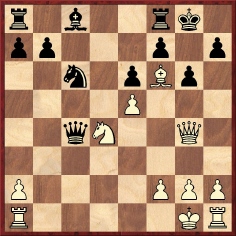
15 Nf5 Resigns, i.e. the game which is recorded in books as a
win by Alekhine against Muñoz at Sabadell, 1945. Unusually, there
is photographic evidence which provides clues, a number of
pictures from the tournament having been provided by our
correspondent Miquel Artigas of Sabadell in earlier C.N. items.
Alekhine’s tournament schedule was given, together with the available game-scores, on pages 727-728 of Alexander Alekhine’s Chess Games, 1902-1946 by L.M. Skinner and R.G.P. Verhoeven (Jefferson, 1998):
Round one (2 August): Alekhine v Vallés. ½-½.
Round two (3 August): Mena v Alekhine. 0-1. Game unavailable.
Round three (4 August): Alekhine v Vilardebó. ½-½. Game unavailable.
Round four (5 August): Terrazas v Alekhine. 0-1.
Round five (6 August): Alekhine v Ros. 1-0. Game unavailable.
Round six (7 August): Medina v Alekhine. ½-½.
Round seven (8 August): Alekhine v Pérez. 1-0. Game unavailable.
Round eight (9 August): Lupi v Alekhine 0-1.
Round nine (10 August): Alekhine v Muñoz 1-0.
See, furthermore, pages 225-235 of A. Alekhine Agony of a Chess Genius by P. Morán (Jefferson, 1989) and pages 291-304 of the original Spanish edition, Agonía de un Genio (Madrid, 1972).
With this documentation on hand, what conclusions, if any, can be drawn about the 15-move game?
Leonard Barden (London) writes:
‘Alekhine had five games as White and four as Black. This means that in a normal tournament draw (round one: 1 v 10, 2 v 9, etc. and round nine 9 v 1, 8 v 2, etc.) he would be in the top half of the pairing table. He never had two successive games as White, which signifies that he was number five in the pairings. That is demonstrated by the crosstable on page 225 of his book ¡Legado! (Madrid, 1946):
The round-by-round pairings given in Skinner and Verhoeven’s book are consistent with the order of the draw shown in the crosstable, i.e. 1 Ros, 2 Medina, 3 Pérez, 4 Lupi, 5 Alekhine, 6 Vallés, 7 Mena, 8 Vilardebó, 9 Terrazas and 10 Muñoz. Assuming normal pairings, this means that the final round was Terrazas v Ros, Alekhine v Muñoz, Vilardebó v Medina, Mena v Pérez and Vallés v Lupi, and that is what is pictorially shown, except that Vilardebó and Medina are only in the group picture – which also has “9 ronda” on the demonstration boards.
The larger group shot (below) also shows a couple of tournament charts above the demonstration boards. The right-hand one seems to be some local subsidiary event, but the left-hand one is complete, with 11 cards, the top one a heading and No. 10 partly obscured by the demonstration board. The names are illegible, but it can be judged whether it is a long or short word, and this too is consistent.
It is therefore absolutely sure that the Alekhine v Muñoz photograph of the French Defence game (see below) is from round nine, after about one hour’s play, as shown by the clocks, and that the 15-move game cannot have been played between those two players in the Sabadell tournament. In any case, apart from his score of only 2/9 in that event Muñoz seems unknown to chess history, and too weak to have played such a sharp variation.
Alekhine v Muñoz, Sabadell, 1945
Alekhine drew with Vilardebó so, on the face of it, the 15-mover would have to be either Alekhine v Pérez or Alekhine v Ros, which are the two missing games which he won as White.
The only other known game by Alekhine in his entire career which opens 1 d4 d5 2 c4 e6 3 Nf3 Nf6 4 Bg5 Bb4+ (most other opponents played 4...Nbd7) appears to be the consultation game Alekhine and Frank v Bogoljubow and Pfaffenroth, Warsaw, 1941. It varied from the 15-mover with 12...Bd7? 13 Rc1 Qa6 14 Nxe6 fxe6 15 Rc8+ Kf7 16 Rxh8 gxf6 17 Qh5+ Ke7 18 Qc5+ Kf7 19 Rf8+ Kg7 20 Qe7 Resigns. See pages 670-671 of Skinner and Verhoeven’s book. The game was also given by Morán in his notes to the 15-mover which he incorrectly headed Alekhine v Muñoz.
In his annotations to the consultation game on page 185 of the 1 December 1941 issue of Deutsche Schachblätter Alekhine commented that “after 12...O-O White would obtain a winning position by means of 13 Qg4 g6 14 e5! (threatening Nf5)”. In other words, the 15-mover had essentially appeared four years earlier.
Ajedrez Español (page 37 of the February 1942 issue) also printed the consultation game, with notes by López Esnaola, although 12...O-O was not mentioned:
Ajedrez Español, February 1942 (submitted by Miquel Artigas)
During his last five years Alekhine normally played 1 e4, mainly reserving 1 d4 for selected stronger opponents. Then after 1...Nf6 2 c4 e6 3 Nf3 Nf6 or b6 he would go into a Catalan or Queen’s Indian. So would a lesser player like Pérez or Ros choose, as Black, an obscure system with such a dubious reputation four years later in Sabadell, and why should Alekhine choose 4 Bg5 rather than his usual 4 g3 against a random opponent when he was not to know that the game would go down the Vienna Variation route?
I met Francisco Pérez (who died in 1999) at the 1958 and 1960 Olympiads, at which time he was a strong and ambitious International Master. Later he emigrated from Spain to Cuba, where he could play on a high board, become the national trainer and compete in the Capablanca Memorial tournaments in Havana. He was theoretically up-to-date in the King’s Indian, which he used in 1958, and I find it hard to believe that he would have tried to surprise Alekhine with a rare dubious line and then fallen into a one-move trap.
In the meeting between Alekhine and Ros one would expect 1 e4 by Alekhine (against a weak opponent) or, if 1 d4, a Catalan. And if Ros really knew enough to choose the sharp Vienna Variation he might be expected to know the above-mentioned consultation game. In the 15-mover Black’s play is both too strong (knowledge of a sharp theoretical line) and too weak (the worst possible move was played at the first opportunity). 14...Nc6 (the only independent move in the 15-mover) is really bad, as it allows not only 15 Nf5 but also 15 Nxc6, after which 15...Qxg4 permits 16 Ne7 mate and if 15...Qxc6 then 16 Qf4, followed by Qh6-g7. It is also worth mentioning that the consultation game was given on pages 230-231 of Schachgenie Aljechin by H. Müller and A. Pawelczak (Berlin-Frohnau, 1953), with a note at move 12 which included the line 12...O-O 13 Qg4 g6 14 e5 Nd7 15 Qf4 Nxf6. However, 14...Nd7 is answered by 15 Nf5. The German book was obviously unaware of Alekhine’s annotations in Deutsche Schachblätter, which is surprising as Müller was a well-known theoretician. However, the book’s other suggested reply to 14 e5 is 14...Re8, which creates a hole for the black king at f8 and therefore stops the 15 Nf5 trick.
Of course, if Alekhine won the 15-mover against neither Pérez nor Ros that means that it was not played by him in the Sabadell tournament at all. There is also the dog that failed to bark in the night argument. It has not been shown that “Alekhine v Muñoz” appeared in print before the original Spanish edition of Morán’s book in 1972, yet other Alekhine miniatures from the war years were published in contemporary sources. Alekhine, in 1945, badly needed to improve his public image following the anti-Semitic articles controversy. How better to do so than by a 15-move queen sacrifice game (never mind that it was analysis) which every space-limited chess journalist the world over would pounce on? But Alekhine himself, his publicist Lupi, who was present, Medina, who was a chess journalist and was also present, and the Sabadell organizers all kept silent. In particular, the game did not appear in Alekhine’s book ¡Legado!, which, indeed, had no games from the event. So was the game ever played, or did somebody merely create it from Alekhine’s annotations to the consultation game in Deutsche Schachblätter?’

All but one of the signatures seem identifiable: S. Reshevsky, Albert Sandrin, Jacob Levin, Kathryn M. Slater, Walter B. Suesman, N.N. and G. Kramer.
The autographs were gathered at the US Championship at New York, 1946. Mrs Slater was a participant in the women’s championship, as mentioned on page 128 of the November-December 1946 American Chess Bulletin. The photograph below was published on page 7 of the December 1946 Chess Review:

Kashdan v Horowitz, Kramer v Steiner and Denker v Reshevsky
How many players have been given, or have given themselves, the title ‘blindfold world champion’? Below are two cases which we have noted recently:
1. Opposite page 74 of the London Chess Fortnightly, 14 January 1893 was a photograph of ‘J.H. Blackburne, Blindfold Champion of the World’.
2. Page 241 of CHESS, July 1946 had an article entitled ‘My Sixth US Tour’ by George Koltanowski (‘World’s blindfold chess champion’).
Around 1640-41, during the reign of Charles I of England, a young man named William left his native land for the New World. Settling in Boston, he took employment as a servant and soon began ‘his courtship of a comely serving maiden’, Dorothy Crosbey. They were married in June or July 1641 and had, between 1642 and 1671, ten children, the third of whom was named Moses.
William, who lived until 1686, was the common ancestor of the Pillsbury family in, to use the modern term, the USA, and in the eighth generation there came Harry Nelson Pillsbury. The direct lineage was as follows.
1. William Pillsbury (died 19 June 1686)
2. Moses Pillsbury (born circa 1645; died 1701)
3. Caleb Pillsbury (born 27 July 1681; died 1759)
4. Caleb Pillsbury (born 26 January 1717; died 7 February 1778)
5. Caleb Pillsbury (born 27 March 1752; died 17 September 1832)
6. Caleb Pillsbury (born 17 December 1786; died 17 March 1874)
7. Luther B. Pillsbury (born 23 November 1832)
8. Harry N. Pillsbury (born 5 December 1872).
All the above details are taken from the remarkable book mentioned in C.N. 4380, The Pillsbury Family by David B. Pilsbury and Emily A. Getchell (Everett, 1898).
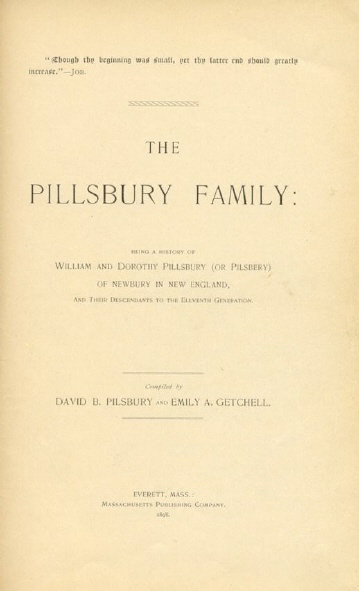
In addition to the information quoted in our earlier item, page 162 of the book states that Harry Nelson Pillsbury’s father, Luther, had a second marriage, to Mary A. Libby on 9 February 1895, and the entry contains the following note:
‘Mr Pillsbury was a graduate of Dartmouth College, and for a number of years taught school successfully in different towns of Massachusetts and New Hampshire. Of late years has been engaged in real estate and insurance business, in Somerville. Mrs Pillsbury was a teacher before her marriage, and was a writer of pleasant verse for several publications. Harry, the youngest son, has won name and fame as a chessplayer in America and Europe.’
As regards ‘Nelson’ it may be mentioned that the chess master’s grandfather, Caleb, married Nancy Nelson in 1808. More information about Luther Pillsbury and his family is given at an ‘Historic leaves’ webpage, from which it will be noted that he died on 8 March 1905. Later that month Harry N. Pillsbury spent a grievous period in hospital, as described in our feature article Pillsbury’s Torment.
Addition on 18 October 2021: Updated link concerning Luther Pillsbury.
From Tim Harding (Dublin):
‘He was indeed George William (and not Williams) Lyttelton, as is shown by all the regular (i.e. non-chess) reference works (such as Cokayne’s Complete Peerage, Burke’s, Debrett’s, the Oxford Dictionary of National Biography and Alumni Cantab). I have no idea how Gaige made his mistake.’
We now note that in the 1994 (privately-circulated) edition of Chess Personalia Jeremy Gaige amended ‘Williams’ to ‘William’.
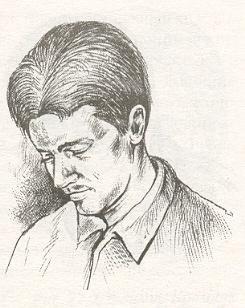
No readers identified Alexander Khalifman, in a sketch taken from page 167 of Ruslan Ponomariov Put’ chempiona (Moscow, 2004). For purposes of comparison, a signed likeness of Khalifman from our collection is given below:
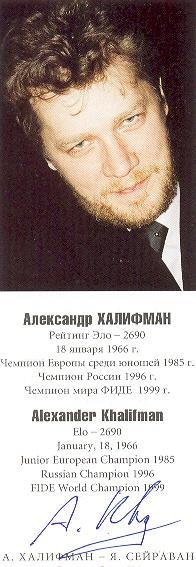
References to chess in comic book fiction seem rare, but an example is shown here from the 9/1981 issue of The Mighty Thor:
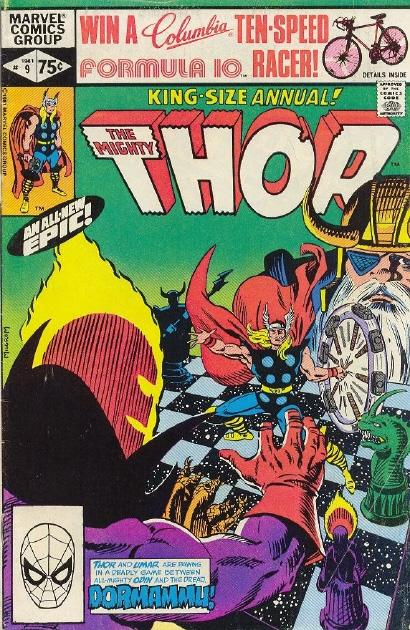
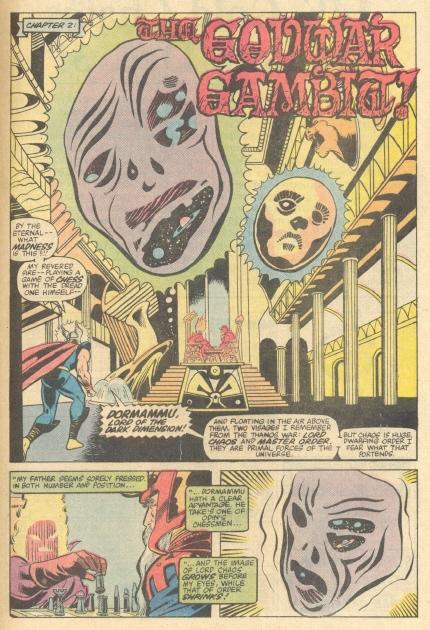
A further specimen of the dialogue is given below:
‘I was ensorcelled by Umar and her G’uranthic Guardian. They stripped away my Asgardian persona ...’
‘Considering the general sad state of chess knowledge 200 years ago, and the fact that he made his mark in other fields, Jean-Jacques Rousseau played a respectable game.’
So wrote Irving Chernev when giving, on pages 330-331 of 1000 Best Short Games of Chess (New York, 1955), the score of the game Rousseau v Conti, Montmorency, 1760: 1 e4 e5 2 Nf3 Nc6 3 Bc4 Bc5 4 c3 Qe7 5 O-O d6 6 d4 Bb6 7 Bg5 f6 8 Bh4 g5 9 Nxg5 fxg5 10 Qh5+ Kf8 11 Bxg5 Qg7 12 f4 exd4 13 f5 dxc3+ 14 Kh1 cxb2 15 Bxg8 bxa1(Q) 16 f6 Qxg8 17 Bh6+ Qg7 18 Bxg7+ Kg8 19 Qe8 mate.
As will be shown below, it was known well before Chernev’s time that the game was not played by Rousseau, but when anything to do with chess is attached to a famous name the two often become indissociable.
Knowledge of the chess activity of Jean-Jacques Rousseau (1712-1778) is chiefly derived from his autobiography Les Confessions, published a few years after his death. In the fifth book he described his introduction to the game at the hands of Gabriel Bagueret of Geneva, and in book seven he recorded meeting chessplayers in Paris (‘je fis là connaissance avec M. de Légal, avec un M. Husson, avec Philidor, avec tous les grands joueurs d’échecs de ce temps-là’) and chronicled the lack of improvement in his own play. Book ten described his chess encounters with Prince Conti.
These passages are too familiar to be quoted here, and English translations may be found in many chess books, such as:
- Chess Pieces by N. Knight (London, 1949), pages 131-134.
- The Chess Reader by J. Salzmann (New York, 1949), pages 103-105.
- The Treasury of Chess Lore by F. Reinfeld (New York, 1951), page 271.
- Caissa’s Web by G. Harwood (London, 1975), page 104.
- A History of Chess by H. Golombek (London, 1976), pages 116-117.
Moreover, the complete text of Rousseau’s Les Confessions is readily found on-line.
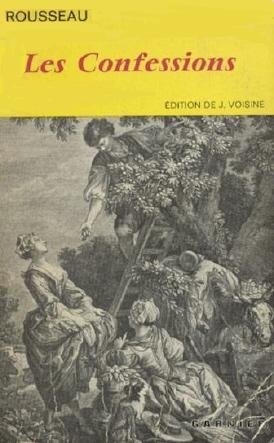
The above game allegedly played between Rousseau and Prince Conti (1717-1776) was given wide currency by James Mason on pages 124-125 of Social Chess (London, 1900). He dated it 1759 and stated that the finish was ‘16 f6 and wins’. When the book was reviewed on pages 53-56 of the February 1900 BCM, a full page was devoted to discussing the Rousseau v Conti game:
‘We are not aware of the source from which this has been drawn; the only original treatise on chess published in France during last century was the Traité des Amateurs, 1775, and this was mainly devoted to odds games. Where then was this game preserved? In an age when even the ten match games between Philidor and Stamma were allowed to drop into oblivion, and in a country whose players were even more backward in recording games than were the English contemporaries of Philidor, who would have recorded this one, and with what object? The passage relating to chess in Les Confessions has an interest of its own, but lends no support to the ascription of this game.’
After summarizing chess-related passages from Les Confessions (including Rousseau’s reference to having bought a chess set and a copy of the Calabrese, i.e. Greco), the BCM review continued:
‘From all this it would appear that Rousseau never attained any particular proficiency at chess, nor regarded himself as a good player; but its chief value for the purpose in hand lies in the reference to Greco.’
The BCM then pointed out that the first 11 moves of the Rousseau v Conti game ‘will be found in Greco (Lewis’s translation, 1819, page 21)’ and observed regarding a remark by Mason (‘White plays very brilliantly’):
‘Quite so; that is a good reason why the authenticity of the game should be suspected; it is the play of a pupil who has not merely learnt his opening by heart but who has so thoroughly entered into the spirit of his brilliant master that when thrown on his own resources by a deviation from his “book” he can continue and wind up the game in a manner hardly surpassed by anything to be found in that book. Who, in the light of his own narrative, would venture to say that Jean-Jacques was such a pupil? We suspect that the concluding portion of the game is the work of an Italian author subsequent to Greco, and was intended to complete his analysis on a point where it was regarded as deficient; as to how the game came to be associated with the name of Rousseau we prefer to reserve our conjectures, ignoring the source from which Mr Mason obtained it.’
A few years later I. Grünberg wrote, with research assistance from Alexis François, an academic article ‘Rousseau joueur d’échecs’ on pages 157-174 of Annales de la société Jean-Jacques Rousseau, volume three (Geneva, 1907).
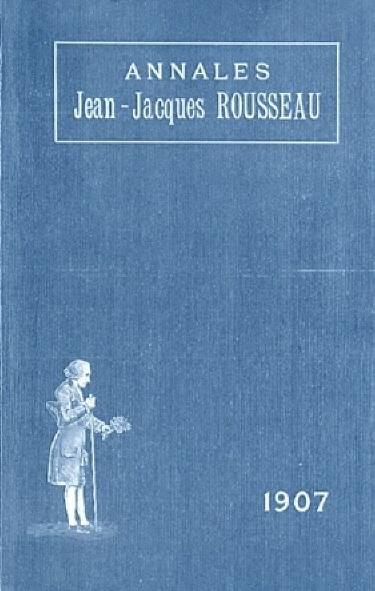
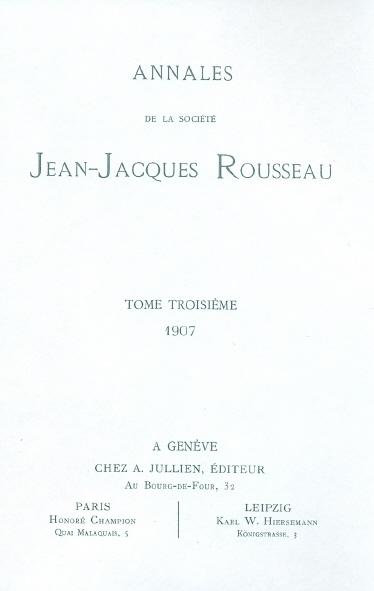
Grünberg began not with Les Confessions but with an extract from a letter written by Rousseau to M. de Saint-Germain (Monquin, 26 February 1770):
‘Le jeu: je ne puis le souffrir. Je n’ai vraiment joué qu’une fois en ma vie, au Redoute à Venise; je gagnai beaucoup, m’ennuyai, et ne jouai plus. Les échecs, où l’on ne joue rien, sont le seul jeu qui m’amuse. Je n’ai pas peur d’être un Béverley.’
Turning to Les Confessions, Grünberg quoted not only the usual passages but also a reference, in book ten, to Rousseau’s desire in Montmorency to play chess against two acquaintances, Ferraud (or Ferrand) and Minard:
‘Je ne sais pas pourquoi ils se souciaient de moi; pour moi, je ne me souciais d’eux que parce qu’ils jouaient aux échecs; et, pour obtenir une pauvre petite partie, j’endurais quatre heures d’ennui.’
Next, Grünberg discussed Rousseau’s well-known remark to Prince Conti, also in book ten of Les Confessions, about having too much respect for the Prince not to beat him at chess. (‘En finissant, je lui dis d’un ton respectueux, mais grave: Monseigneur, j’honore trop Votre Altesse Sérénissime, pour ne la pas gagner toujours aux échecs.’) Noting that a nineteenth-century writer on Rousseau, Saint-Marc Girardin, had opined that Rousseau did not speak those words, Grünberg disagreed, pointing out that Rousseau had related the same version to Pierre-Alexandre Du Peyrou in a letter dated 27 September 1767.
Grünberg then suggested that Rousseau understated his chess skill, given that he won games against Prince Conti, who ‘passait pour un joueur habile, élève du chevalier de Lorenzi’. The article gave the moves of the Rousseau v Conti game, unquestioningly specifying the source as follows in a footnote:
‘Ce document a été reproduit par la revue Le Palamède, année 1843, p. 41-42, au milieu d’une fantaisie de Marie Aycard, intitulée “Jean-Jacques et le Prince de Conti”. L’original avait été communiqué à la revue par un de ses abonnés, M. Doazan, “possesseur de fort curieux manuscrits sur les échecs au siècle dernier”.’
After quoting from Richard Twiss’ book Chess (London, 1787) that ‘Rousseau was very inexpert at chess, though an enthusiastic admirer of it’, Grünberg stated that an opponent of Rousseau’s, the Abbé Jean-Joseph-Thérèse Roman, had handed down to posterity a detailed written account of one of their games, in a lengthy poem probably composed in 1762. Grünberg noted that the fourth chant (i.e. canto) related Roman’s victory over Rousseau and that the account, the poem and the game-score had been published in Le Palamède, 1836 (pages 265-279). Below are the moves as they appeared in that earlier source:
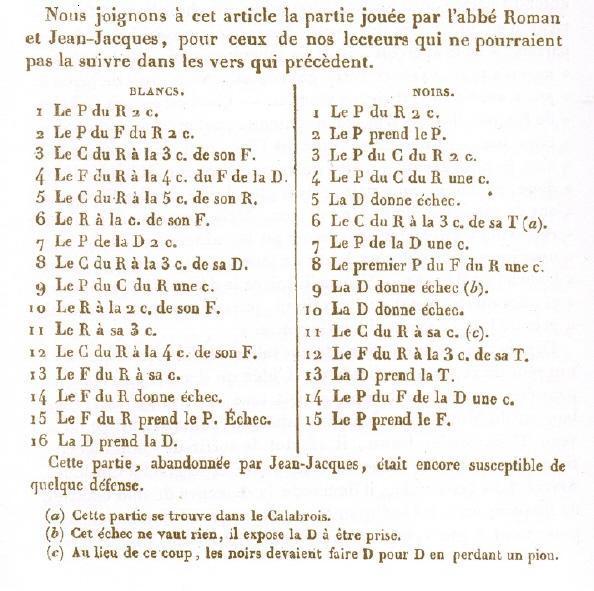
The moves were thus as follows: 1 e4 e5 2 f4 exf4 3 Nf3 g5 4 Bc4 g4 5 Ne5 Qh4+ 6 Kf1 Nh6 7 d4 d6 8 Nd3 f3 9 g3 Qh3+ 10 Kf2 Qg2+ 11 Ke3 Ng8 12 Nf4 Bh6 13 Bf1 Qxh1 14 Bb5+ c6 15 Bxc6+ bxc6 16 Qxh1 Resigns.
Grünberg drew a number of conclusions about Rousseau from the above game, which, in common with the Conti score, he assumed to be genuine.
His article attracted attention, and not least after most of it was reproduced in La Stratégie, June 1908, pages 165-177. Shortly afterwards, H.J.M. Murray contributed an article entitled ‘Rousseau and Chess’ to the August 1908 BCM, pages 329-331, praising Grünberg’s industry and building on the information provided, to demonstrate that neither game attributed to Rousseau was genuine. As regards the philosopher’s meeting with Prince Conti, Murray wrote:
‘A fictitious account of this meeting was written by Marie Aycard for the Palamède in 1843, and in the course of the story the game to which I have referred is given. It is pretended that the Chevalier de Lorenzy had taken it down at the time, and that M. Doazan had supplied it from the MS. All this is very circumstantial, but the only piece of truth in it is the fact that M. Doazan had supplied the game from a MS in his possession. But this MS was not the work of de Lorenzy, neither did it contain eighteenth-century games. The only MS in Doazan’s possession was the so-called “Doazan MS”, which was described in the Palamède in 1843; and at a later time, after William Lewis had publicly expressed doubts as to the genuineness of the MS, it was seen by v.d. Lasa in 1855. V.d. Lasa extracted the games, and circulated them among his friends in a lithographed edition, under the title of Recueil de Parties d’Echecs, Bruxelles, 1855. The MS has disappeared since the sale of M. Doazan’s library in 1865, but, thanks to v.d. Lasa, we know exactly what the MS was, and what it contained. It was an Italian compilation of the early seventeenth century, the work of some admirer or companion of that Polerio who accompanied Leonardo – il Puttino – on his journey to Madrid to play Ruy López, about 1575. That the supposed game Rousseau v the Prince de Conti was obtained from this MS is quite clear, for it occurs there from the first move to the last. There, however it is given as from the play of the Spaniard Busnardo, a contemporary of Ruy López. The Doazan MS stands in close connection with an Italian MS at Paris (It. 955), and the same game occurs in this MS, with the title, “Altra manera d’uscire del busnardo”. It is clear that the modern ascription of the game is as fictitious as the story in which Aycard set it, and that later writers have made the easy mistake of treating chess fiction as chess history.’
Murray then described the circumstances of the Roman v Rousseau game and concluded:
‘... The game proves to be a Greco game (Hoffmann’s Games of Greco, ch. xlvi, page 125), and we must accordingly reject this game also as a literary forgery. We possess no genuine example of Rousseau’s play, and perhaps it is as well for his reputation that it is so. A player who either would not or could not make a scientific study of the game, who derived no benefit from practice with Philidor, who reached the limit of his powers in a single day, assuredly could know nothing of the brilliancy of chess.’
The article by Murray was mentioned on page 95 of the Chess Weekly, 22 August 1908, which offered some general thoughts on Rousseau’s chess prowess:
‘There is a sort of credit which comes to a brilliant man from doing badly what other and less gifted mortals do extremely well; and when Rousseau gives account in the Confessions of his not merely indifferent but conspicuously abject skill at chess, declaring that he never improved beyond the point he reached on his first day’s acquaintance with the game, we think he was fully aware of the paradox involved, and wittingly sacrificed the essential truth of his words to their literary effect. It would, indeed, be picturesque incapacity which did not measurably profit by exercise and experience; and if, contrary to his wont, Rousseau deceived himself upon this point, it must have been that he knew so little of the game as not to have a competent opinion whether he progressed or not. It is, of course, hard to detect improvement in your own game from day to day; but when the period of observation is long enough, it is as apparent as the moon’s increase.
It is, however, the way of confession to exaggerate, and Rousseau was far too shrewd not to see that, by proclaiming himself a negative monstrosity at chess, he could very well serve not only his taste for confession but also his renown as no ordinary manner of man. It is, to be sure, a trifling incident in his book, but a grain of insincerity, if such it were shown to be, would pollute all his mighty rivers of confession.
We are reminded of that good old saint who could never – or hardly ever – talk of sinners but he must add, “Of which I am the chiefest”; yet we very well know he was no such thing.’
Murray mentioned Rousseau in a 15-line footnote on pages 861-862 of A History of Chess (Oxford, 1913), where he used the word ‘forgery’ to describe both game-scores discussed above. On page 54 of A Short History of Chess (Oxford, 1963) the man whom his BCM article had described as ‘the Spaniard Busnardo’ was referred to as ‘a Roman player named il Busnardo’. It may be mentioned here that the Rousseau v Conti game had been published on pages 228-229 of the Chess World, 1865. As noted by Murray in his BCM article, the game also appeared on page 1 of Chess Sparks by J.H. Ellis (London, 1895).
A general feature ‘Jean-Jacques Rousseau et les échecs’ by Anatole Mouterde is to be found on pages 253-254 of La Stratégie, December 1919, and six years later an article ‘Jean-Jacques Rousseau joueur d’échecs’ was published in issue four of Les Cahiers de l’Echiquier Français, pages 97-105. It drew heavily on Grünberg’s work, but had no mention of Murray’s. Subsequent features on Rousseau which we have seen show little or no sign of scholarship, one example being on page 59 of the November 1934 issue of El Ajedrez Español (an anecdote about Rousseau and ‘el caballero de La Mothe-D’Urbin’).
Endnote: the above quotations from Les Confessions follow the 1972 Garnier edition edited by Jacques Voisine. It used modern spelling (e.g. ‘j’étais’), whereas Grünberg’s article had the spelling of Rousseau’s day (‘j’étois’).
Avital Pilpel (Haifa, Israel) notes that two early specimens of Salo Flohr’s play were included in a book by Yosef Porat and Eliahu Fasher, Yosef Porat Aman ha’Sachmat, 70 Mishakim Nivharim, which was published in Israel in 1989. The first of them, from page 21, is given below, with Porat’s notes translated by our correspondent. Played in a friendly match between the Silesian and Czechoslovakian German Chess Associations circa September 1928 (‘a few weeks after the July 1928 Olympiad in The Hague’), it is a loss by Flohr to Porat (who was then named Heinz Joseph Foerder):
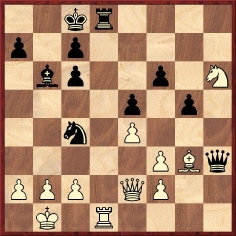
‘Position after 24 ...Qxh3. The white bishop is in a cage.’ 25 Ng4 Rxd1+ 26 Qxd1 Qh8 27 a3 Nd6 28 Qd3 Qd8 29 Qb3 Kd7
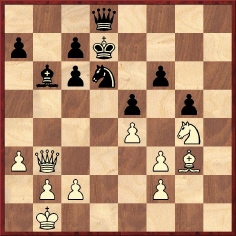
30 Qg8 ‘A small combination with a hole in it. White wins a pawn, but the knight is put in a cage as well.’ 30...Qxg8 31 Nxf6+ Ke6 32 Nxg8 Nf7! ‘Closing the cage. Now Black needs to manoeuvre so as to win the knight without losing the pawn at e5.’ 33 Kc1 Bc5 34 Kd2 Bf8 35 Kd3 Nd6 36 Bh2 Bg7 37 c3 Nc8 38 Kc4 Bf8 39 b4 Nb6+ 40 Kb3 Nd7 41 Ka4 Kf7 42 Ka5 Kxg8 43 Ka6 c5 44 Kxa7 cxb4 45 cxb4 c5 46 bxc5 Bxc5+ 47 Kb7 Kf7 48 a4 Bxf2 49 a5 Nc5+ 50 White resigns.
Is the earlier part of the game extant?
C.N. 4053 asked where exactly Sheriff Spens described Paul Morphy as ‘the pride and sorrow of chess’. No answer has yet been found, but we note that on page 144 of A History of Chess (London, 1976) H. Golombek attributed the phrase to Fiske.
From page 51 of A. Alekhine Agony of a Chess Genius by P. Morán (Jefferson, 1989):
‘The 1942 “switched envelopes” anecdote best illustrates Alekhine’s patriotism: he mailed a pro-Communist letter to the Third Reich, and a pro-Nazi letter to the USSR.’
How far back can this story be traced?
Dominique Thimognier (St Cyr sur Loire, France) offers an addition to our Chessy Words feature article: chessicide. He points out that the word occurs at the website of the Fédération québécoise des échecs, in a report (no original source given) on a tournament held in Canada in 1956. Can a reader provide us with an exact citation for ‘chessicide’ from that time?
From Jerry Slocum (Beverly Hills, CA, USA):
‘Sam Loyd did not invent the 15 Puzzle (or the 14-15 Puzzle) and had nothing to do with promoting or popularizing it. This is one of the surprising findings in a new book, The 15 Puzzle, which I have written with Dic Sonneveld. It describes and illustrates the true story of the invention, patent application and manufacturing of the puzzle.
A huge puzzle craze was created by the 15 Puzzle which began in January 1880 in the USA and in April in Europe. The craze ended by July 1880, and Sam Loyd’s first article about the puzzle was not published until 16 years later, in January 1896. Loyd first claimed in 1891 that he invented the puzzle, and he continued until his death a 20-year campaign to take false credit for the puzzle. Loyd also falsely claimed that he invented the game Parcheesi and a dexterity puzzle named “Pigs-in-Clover” that generated another puzzle craze in 1889.
The actual inventor of the 15 Puzzle was Noyes Palmer Chapman, the postmaster of Canastota, New York, and he applied for a patent in March 1880.’
Our correspondent’s book can be acquired direct from him on-line, inscribed if so wished.
What are the highest prices for which any old chess piece, set or board has been sold (e.g. at auction)?
The opportunity is taken here to quote a line from Alan Bennett’s masterly play The History Boys:
‘We venerate supine antiquity. In our catechism, old is good, older is better, ancient is best, with a bonus on archaeology because it’s the closest history comes to shopping.’
From pages 214-215 of the City of London Chess Magazine, October 1874:
‘Most persons are well posted up in the Beecher-Tilton scandal, but lest any, through much playing at chess, should have had their attention otherwise occupied, we give the following item, which depicts one trait of Mr Tilton’s character, though we are not aware that it casts much light upon the great point in debate. It is taken from Mrs Tilton’s evidence. She says that her husband, at one time, “was absorbed in chess to such a degree that he would sometimes be up all night; I have known him to stand up at night ready for bed, engaged upon a problem in chess, and to be found in that same condition in the morning, without having gone to bed at all”. We cannot deny that Mr Tilton, at this time, loved chess, “not wisely, but too well”, though query whether his depreciation of character did not begin after his devotion to problems had worn off.’
Henry Ward Beecher, a prominent pastor, was accused by his friend Theodore Tilton of adultery with his wife, Elizabeth Tilton, and there developed one of the nineteenth century’s most celebrated scandals. It is chronicled in great detail in a book published in 1999, Trials of Intimacy by Richard Wightman Fox, who is Professor of History at the University of Southern California.
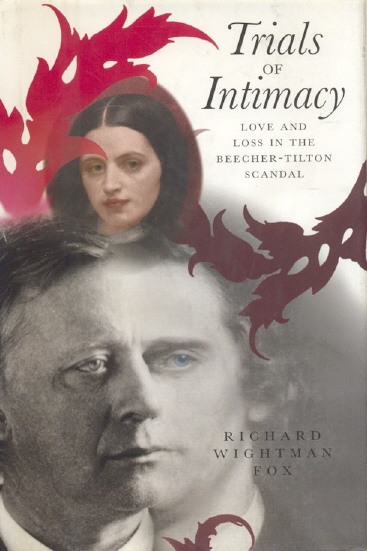
Professor Fox informs us:
‘At the start of my book, in the section on Tilton’s last years in Paris, I mention that he spent his time then at a Parisian café playing chess. In his earlier years in Brooklyn he played chess too, and Elizabeth Tilton’s comment was well known in 1874-75 at the time of the Beecher-Tilton scandal. Whether it is accurate we shall never know – so many exaggerated statements were made by Elizabeth, Theodore, and Henry Ward Beecher. She was trying to discredit her husband in that period, and her comment about chess was designed to portray him as obsessive, compulsive, inattentive to her and to their children, etc. And yet it would have been completely in character for him, once in a while, to stay up all night writing, reading or playing chess. He was a restless, preoccupied, imaginative intellectual, and during the scandal years he was higher-strung than usual. So on a truth-scale of 1 to 10 it strikes me as a 7 or higher.’
The relevant passage (on pages 11-12 of Trials of Intimacy) about Theodore Tilton’s time in Paris is quoted below:
‘When Frederick Douglass, his comrade from antislavery days, came through Paris in January 1887, the London correspondent of the New York Times was on hand to record that “the two heavy, large-featured, distinguished looking men, with their massive heads of white hair, attracted very general notice on the boulevards”. The reporter did not speak to Tilton, but friends said he was renting “a floor in a grand old mansion ... on the Ile de Paris, back of Notre Dame ... Most often he is to be met late afternoons at the Café Régence, one of the very few of the famous pre-Revolution resorts which the Haussmannization of the right bank of the Seine has left intact. Here for a century and more have the best chessplayers of Paris assembled”. When his old friend Elizabeth Cady Stanton, the women’s rights leader, visited Tilton in the spring of 1887, “they played some exciting games of chess ... in the pleasant apartments of the late W.J.A. Fuller, Esq., and his daughter, Miss Kate Fuller”.’
An intriguing point in this account is the reference to W.J.A. Fuller, which comes from E.C. Stanton’s 1898 book Eighty Years and More. We take it to be the American William James Appleton Fuller, who died in Paris in 1889 (International Chess Magazine, April 1889, page 107). Fuller, it may be recalled, was a friend of Paul Morphy; see, for instance, the photograph which Morphy inscribed to him, on page 212 of Paul Morphy The Pride and Sorrow of Chess by David Lawson (New York, 1976).
A number of C.N. items (see, in particular, pages 11-12 of Chess Facts and Fables and C.N. 3773) have tussled with the question of whether a player named Fox won two games, around the same time, with an extremely rare queen sacrifice:
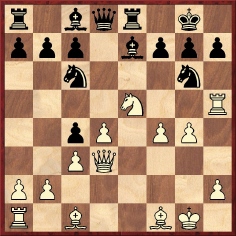
Fox v Bauer: 18 Qxg6
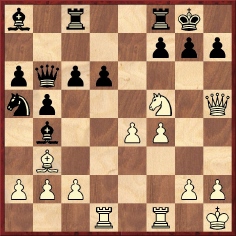
Fox v Karper: 21 Qg6
At the conclusion of C.N. 3773 we wrote:
‘But were the two games featuring that rarest of queen sacrifices on g6 really played not only by the same person, A.W. Fox, but also within a few months of each other? Were they really played at all? Or are there good grounds for regarding either of them as an invention or hoax?’
Harrie Grondijs (Rijswijk, the Netherlands) now sends us an item by Louis Uedemann in the Chicago Tribune of 12 May 1901, page 20:
‘Now another American youth, Albert Whiting Fox, born 17 years ago, at Boston, is attracting attention to himself by his brilliant play. Two of his games appeared recently in the new American Chess World and contained, as may appropriately be said, some “foxy moves”. They caused chessplayers to wonder who Mr Fox was. The following letter from Paris, France, to J.D. Séguin contains this much desired information:
“I have been going a good deal lately to the Café de la Régence and I had the pleasure of meeting occasionally a young countryman of ours who struck me as being a good chessplayer, and who has fair chances of becoming a ‘master’ of the future. His name is Albert Whiting Fox. He was born in Boston 17 years ago. He spent a few years in Germany, and is now studying the higher branches of mathematics in one of the colleges of this city. He speaks German and French (the latter with the genuine Parisian accent) and is altogether an accomplished and agreeable young gentleman. As a chessplayer he ranks among the best of those who frequent the ‘Régence’, so I suppose some of his games, which I inclose, may prove interesting. They may not be the most favourable specimens of Mr Fox’s play, but they were the only ones I could procure; some of them were played in the course of a recent journey to Washington, DC, where the young man’s parents now reside.”
The first was played at the Café de la Régence, Paris and the second in Antwerp on 31 [sic] December 1900. The latter is unquestionably a remarkable game and, if any recognized master had played it, it would rank among his brilliancies. The average strong player will overlook the object of the sacrifice of the knight on the 17th move, and this, followed by the sacrifice of the queen and another knight, stamps the pretty combination as a genuine masterpiece.
The third and fourth games (from the ACW) are also good. In the third a well-known Washington expert is the victim, and in the fourth a German player. The last game has a similar fierce attack against the king’s side, and ends in a finale as dazzlingly brilliant as the second game.’
The newspaper then gave the four game-scores:
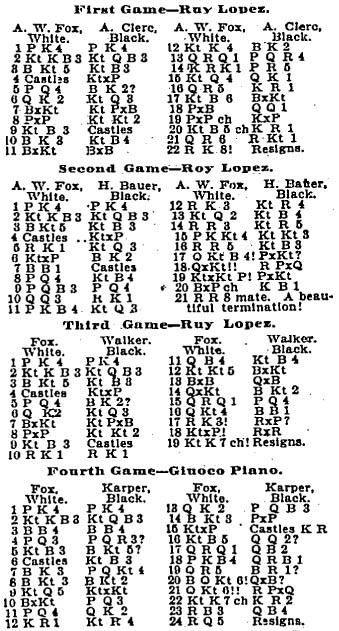
It is difficult to know what to make of all this. Fox would certainly be fortunate to have a correspondent (anonymous) so conveniently placed to relate his exploits at home and abroad. To date, we have found, in the history of chess, only ten games (listed in C.N. 3773) which featured such a queen sacrifice on g6 or g3, yet two of them, both attributed to A.W. Fox, were purportedly played in quick succession and, as shown above, even appeared on the same page of the Chicago Tribune, 12 May 1901.
From Michael Clapham (Ipswich, England):
‘On 9 June 2006 I attended an antique and collectors’ auction in Ashbourne, Derbyshire, held by Hansons Auctioneers. There were a few old books in the sale, including just the one chess book. However, this was a first edition of Arthur Saul’s The famous game of Chesse-play (London, 1614).
Page 26 of David DeLucia’s book A Few Old Friends (Darien, 2003) states that only five copies are recorded, his own and four in major libraries, so this was a hitherto unrecorded copy of the first book on chess by an Englishman, and apparently only the second copy in private hands. It came from a Derbyshire lady who brought it along to a valuation day at the local Women’s Institute.
The auctioneers obviously did not appreciate the rarity of the book and catalogued it without mentioning the author at an estimated price of £200-300. The book made £8,704, including the buyer’s premium.’
The illustration below appeared in a chess magazine. What does it depict?

To judge by the number of correct answers received, this was one of our easiest quiz questions. Mikhail Botvinnik is second from the right, alongside fellow students. The picture was gleaned from page 19 of Mikhail Botvinnik by Kirill Levin (Moscow, 1951):
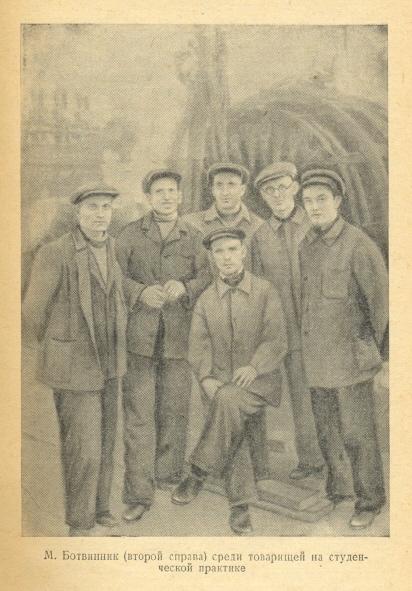
From page 74 of The Fireside Book of Chess by I. Chernev and F. Reinfeld (New York, 1949):
‘In 1851 the Chess Champion of the world was A. Anderssen; the Checker Champion of the world was A. Anderson.’
This is quoted not to prompt a discussion about Anderssen’s chess status in 1851 but to ask whether Anderson was indeed recognized at that time as world champion at draughts/checkers. In C.N. 3030 (see page 269 of Chess Facts and Fables) a correspondent enquired whether chess was the first field to use the title ‘world champion’, a question which remains open.
Jan Kalendovský (Brno, Czech Republic) sends us a copy of the entrance ticket to the 1931 Olympiad in Prague:
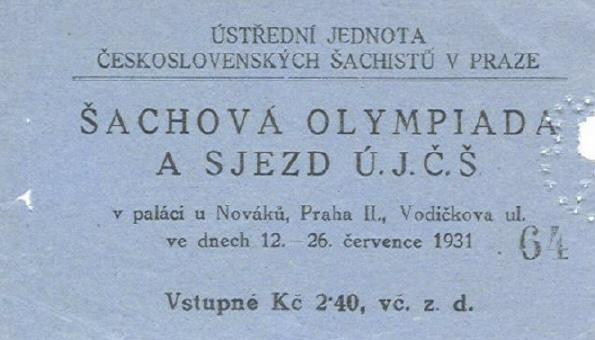
Do any readers possess entrance tickets which are of intrinsic historical interest?
As mentioned in C.N. 3773, Fox annotated his game against Bauer on pages 79-80 of La Stratégie, 15 March 1901. We now reproduce those notes:
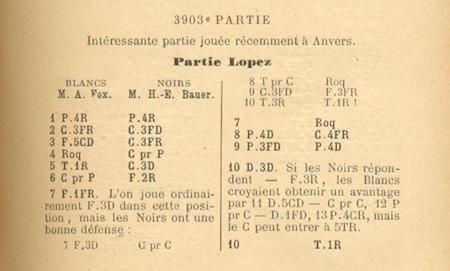
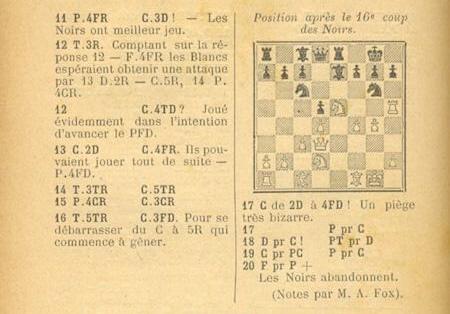
Leonard Barden (London) writes:
‘A.W. Fox used the Ruy López and 4 O-O against the Berlin Defence several times during his period of master play in 1904-06 (which included Cambridge Springs), so I do not see any difficulty with that brilliancy.
However, the Giuoco Piano game against Karper is peculiar in that A.W. Fox (if it is he) eschews his normal Ruy López, then passes over not just the simpler win pointed out by Chernev but also two easy wins earlier. 13 c3 or 13 a3 wins a piece (Black’s bishop at b4 and knight at a5 are in a tangle), while four moves later 17 Qg4 wins instantly with the double threat Qxg7 mate and Nh6+ with Qxd7.
So if the Giuoco Piano is indeed an A.W. Fox game (clearly this is not 100% sure) it seems that, recognizing that he had a cooperative opponent, enjoying the thrill of a brilliancy, and maybe with fond memories of his other Qg6, he declined the easy wins in favour of a flashy finish which he may well have foreseen some way in advance.’
Further to our feature article on Books about Fischer and Kasparov, Michael Syngros (Amarousion, Greece) asks whether Fischer is the master about whom the most volumes have been written. For purposes of comparison, we list below the books in our collection about (not by) Capablanca and Alekhine:
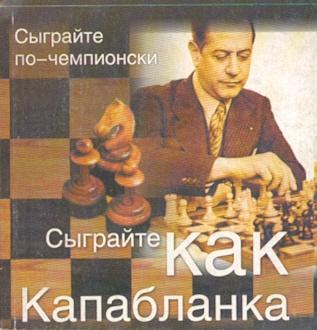
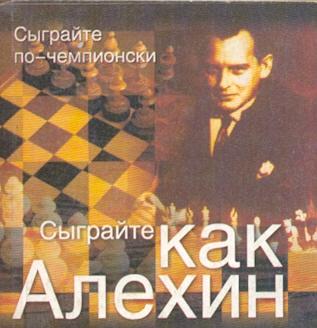
These lists exclude not only volumes by Capablanca and Alekhine but also match and tournament books involving them, as well as works of fiction (e.g. the novels by Kotov and Yaffe concerning Alekhine). Another intentional omission is Alekhine’s Block,which is not specifically about him. One book which we have yet to acquire was mentioned by a correspondent in C.N. 3122: Geniy Kombinatsiy Grossmeister A. A. Alekhin by A. Mirles (Kiev, 1926). Information about any other titles will be much appreciated for incorporation into a future ‘Books about Capablanca and Alekhine’ feature article.
C.N. 4042 quoted this mate-in-two composition by Zukertort:
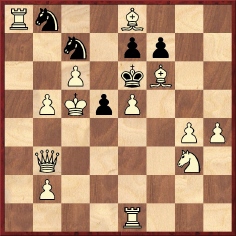
Now, though, we note that the position was discussed by S. Green, a reader of the Chess Player’s Chronicle, on page 250 of the 10 December 1884 issue:
‘Mr Zukertort, in the composing of this problem, has evidently been to some little pains in the endeavour to prove, from the position, Black’s last move. What it may have been I have now nothing to do with, suffice it to say that I can prove from the position that it is not White’s turn to play. A little superficial examination will show that the “author’s intention” was that Black having played pawn from Q2 to Q4 as his last move, White should then continue with P takes P en pass [sic] (double check) and mate with queen. This would be all very well, but for the white bishop on king’s 8th. With the black pawn stationed on Q2 (where it would be prior to its advance according to the Doctor) I fail to see how the white bishop secured so snug a retreat, unless via an adjacent board.
If it does not give the Doctor pain, I might even venture to suggest an alteration which would render the position at least sound, which will be its only merit: remove the black P on KB2, transfer the white Kt to KR6 and then it works.’
Michael McDowell (Westcliff-on-sea, England) comments:
‘Green is quite right that the position is illegal, but his “correction” allows an immediate Bf7 mate. It would be easy enough to correct it properly. Moving the knight from g3 to h6, swapping the white pieces on a8 and e8 and adding a black bishop on d8 seems to work, although the knight on b8 is then superfluous. I do not know why there is a white bishop on f6 rather than a white pawn, or why there is a white pawn on b2 at all.
The problem has no historical value. The subject of the “en passant key” pioneer was discussed by John Beasley in The Problemist for May 2004 (pages 391-392) and September 2004 (page 459). He concluded that the first sound example was an anonymous composition on the cover of Deutsche Schachzeitung, March 1858 and, with the help of Hanspeter Suwe, he determined that Max Lange was the composer. Nowadays we have two-movers with multiple variations after an en passant key (13 being the record).’
Ralph Blewitt (Antwerp, Belgium) draws attention to a webpage providing information about Andrew Anderson and stating that ‘he was the first World Champion the game of draughts produced, a title which was really his from about 1830 until 1848 when he retired undefeated’. Moreover, Robert John McCrary (Columbia, SC, USA) points out a webpage with details about the career of James Wyllie.
Which early primary sources used the term ‘world champion’ with regard to either Anderson or Wyllie?
A further contribution from our correspondent in Belgium is the title page of an 1881 book by Wyllie, in which he is described as ‘champion draughtplayer of the world’:

Richard Forster (Winterthur, Switzerland) notes that volume 42 of the Annales de la Société Jean-Jacques Rousseau (Geneva, 1999) has, on pages 95-145, an academic article by Jacques Berchtold entitled ‘Rousseau, joueur d’échecs au café 1770-1771’.
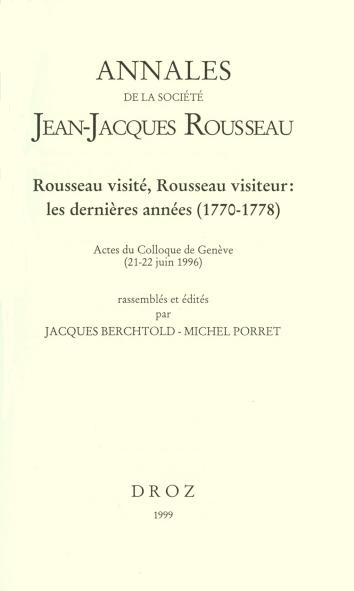
After a discussion of Rousseau’s earlier chess activity, the article focuses on his visits to the Café de la Régence, which began shortly after he returned to Paris on 24 June 1770. Eye-witness reports are quoted, but there is no account by Rousseau himself, as he was conspicuously silent on the subject.

From Antero Leitzinger (Helsinki):
‘According to the chess column in a Finnish newspaper, Svenska Pressen, 29 October 1932, Antti Favén offered his painting as a prize at the annual Finnish championship tournament. In his speech, Favén referred to his friendship with Marshall and other players at the Café de la Régence, which suggests that the painting portrayed those players. The painting and a copy of it (I do not know which is the original) adorn the walls of the Stockholm Chess Union and of Shakkikoti, a chess club room in Helsinki. According to Calle Erlandsson in C.N. 3770, the former picture was donated by Erik Lundin, which is confirmed by Eero E. Böök in his article in the 10/1980 issue of the Finnish chess magazine Suomen Shakki, pages 294-295. Lundin himself, however, made no mention of acquiring the painting in his memoirs Erik Lundin spelar upp sina schackminnen 1924-1979 (Skara, 1979).
Under the rules set out in Favén’s speech, as quoted in Svenska Pressen, the painting was to be awarded to whichever player won the Finnish championship three times. This means that Böök should have received it in late April 1936. However, in the newspaper Uusi Suomi, where Böök had a weekly chess column at the time, no mention was made of his receiving the painting after the tournament. Nor did Böök explain in his later (1980) article why the painting ended up in Sweden, but he did reproduce the picture with suggestions as to the identities of some of the figures: Tarrasch (in the background), Marshall (with a cigar), Janowsky (with a cigarette, on Marshall’s right), Burn (seated in front of Marshall, with a pipe), and Bernstein (facing Burn). On the basis of a Swedish pamphlet, Böök claimed that Favén produced the painting over a long period, from 1902 to 1913.
Page 29 of a publication by a Finnish art museum, Antti Favén 1882-1948 (edited by Ulla Huhtamäki, Hämeenlinnan taidemuseon julkaisuja 3, Toijala, 1992), mentions Favén having worked on his painting in autumn 1910. It also refers to a Finnish newspaper, Nya Pressen, of 4 October 1910, but the date is incorrect, as there was nothing about Favén in that issue.
Yrjö Antti Favén was a cosmopolitan Finn, born in Helsinki, who lived in Paris for many years, working in the rue Saint-Senoch. In 1938 or 1939 he finally moved to Sweden, and in 1946, only two years before his death, he became a Swedish citizen.’
A question which arises is whether Faven’s painting depicts players whom he met at the Café de la Régence or, indeed, whether some of the portraits were based on photographs and others were fictional.
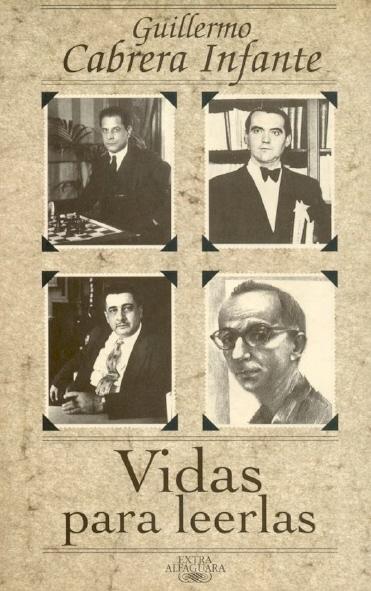
The Cuban-born writer Guillermo Cabrera Infante (1929-2005) published an essay on Capablanca entitled ‘Capa, hijo de Caissa’ on pages 211-234 of Vidas para leerlas (Madrid, 1998). Many facts were wrong, and it is hard to know what to make of a passage on pages 218-219. It asserted that during the First World War Capablanca was questioned by two counter-intelligence agents from Washington about correspondence which included several moves in chess notation. With a straight face Capablanca said, ‘They are symbols for a freeing manoeuvre’ (as indeed they were, in the Queen’s Gambit Declined) but he then explained, with the aid of a board, that they were chess moves. The complete paragraph featuring this yarn, which we do not recollect seeing elsewhere, is quoted below:
‘Capa permaneció en los Estados Unidos durante la Primera Guerra Mundial, jugando, y se escribía sobre asuntos de ajedrez (¿de qué otra cosa?) con el campeón Lasker, ciudadano alemán y judío patriota. Un día de 1918 vinieron a visitarlo dos discretos caballeros de Washington. Eran del servicio de contrainteligencia que investigaban su correspondencia extranjera, llena de extraños símbolos: 10BXe7 Qxe7 11O-O NXC3 12RXC3 e5. “¿Qué clave es ésta?” Muy serio, Capablanca respondió: “Son símbolos para una maniobra de liberación”. “¿Cómo?”, dijeron los dos agentes al unísono. Capa a carcajadas escapa: “Son signos del ajedrez, una convención internacional.” Después de explicaciones y ejemplos con el auxilio de un tablero y varias fichas, los policías comprendieron. “¡Ah, es como las damas!” “¡Efectivamente – dijo Capa –, como las damas pero con caballeros!” Capablanca se dio cuenta de que la contrainteligencia es lo contrario de la inteligencia. Y sin embargo, sin embargo: Emanuel Lasker había ya inventado un tanque de guerra para el enemigo que era todavía su amigo.’
That managed to fill two-thirds of a page in Vidas para leerlas, but to what purpose and on what grounds?
The well-known Steinitz/Chigorin ‘spy code’ tale, together with a similar one involving Lorenz Hansen, was discussed in C.N. 3345 (see pages 243-244 of Chess Facts and Fables). As regards the assertion in the final sentence quoted above that Lasker invented a tank, we know nothing beyond what appeared in C.N. 3650, namely that the claim was made by Reuben Fine.
C.N. 2872 discussed the game Torre v Parker (1 e4 e5 2 Nf3 Nc6 3 Bc4 Nf6 4 d4 exd4 5 O-O Bc5 6 e5 d5 7 exf6 dxc4 8 Re1+ Be6 9 Ng5 Qd5 10 Nc3 Qf5 11 Nce4 O-O-O 12 g4 Qe5 13 Nxe6 fxe6 14 fxg7 Rhg8 15 Bh6 Bd6 16 f4 Qa5 17 Qf3 Qd5 18 g5 Bc5 19 Kg2 Be7 20 Nf6 Bxf6 21 Qxd5 Rxd5 22 gxf6 Rf5 23 Rxe6 Nd8 24 Rae1 Nxe6 25 Rxe6 d3 26 cxd3 cxd3 27 Kf2 d2 28 Ke2 Rd8 29 Kd1 Rc5 30 White resigns), which became famous because in the final position ...
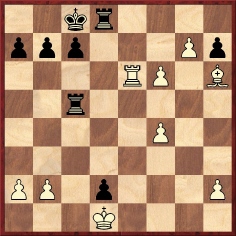
... Torre could have won with 30 Rd6.
See pages 5-6 of Chess Facts and Fables, but our book should have included the following supplementary information from Jack O’Keefe (Ann Arbor, MI, USA) which appeared in C.N. 2874:
‘It seems that the game was played on 16 September 1924.
“In his first simultaneous exhibition at the rooms of the Marshall Chess Club Tuesday evening, Carlos Torre was opposed by ten players. After two hours and 30 minutes the Western champion finished with a score of eight wins and two losses. The winners were Z.L. Hoover, secretary of the Correspondence Chess League of America, and F. Parker, former champion of the Marshall Chess Club.” (Brooklyn Daily Eagle, 18 September 1924, page A3.)
The next week’s column (25 September 1924 issue, page A3) gave the game with this introduction:
“Befitting a modest young man, Torre does not believe in concealing the successes of opponents, which are rare enough, goodness knows, under a bushel. A case in point, and quite a strange incident, is his game with F.E. Parker in his simultaneous exhibition at the Marshall Chess Club, where Torre won eight and lost two. After 29 moves the young Mexican resigned. He had no sooner done this than it flashed across his mind that he had missed a good reply, but, having given up the game, he allowed the decision to stand. Further examination showed that he actually had a winning continuation in hand.”
Then the score is given (just as you have it) followed by this note:
“Instead of resigning, White could have won by force as follows: 30 R-Q6 (a real problem move) RxR 31 P-Kt8(Q)ch K-Q2 32 Q-B7ch K-B3 33 Q-K8ch K-Kt3 34 Q-K3 and wins. If 32...K-Q 33 Q-B8ch K-Q2 34 QxRch PxQ 35 P-B7 and wins.”
A footnote came a few weeks later (30 October 1924, page A3):
“With reference to the game which Frank E. Parker won from Torre in the latter’s simultaneous exhibition at the Marshall Chess Club, it should be stated, in justice to Mr Parker, that it was he who was the first to point out the problem move by means of which his opponent might have won the game he actually resigned.”’
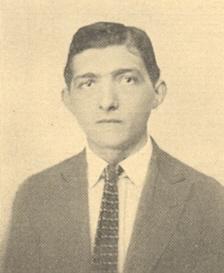
Carlos Torre
‘Fischer Talks Chess’ was the title of a column which began in the June 1963 Chess Life. As noted on page 166 of A Chess Omnibus, some of the material was subsequently used, in revised form, in My 60 Memorable Games. On pages 302-303 of the December 1963 issue Fischer wrote up his win over Bisguier at that year’s New York State Open Championship (game 45 in the book). Thus his famous remark about 1 e4 (‘Best by test’) appeared in print in 1963.
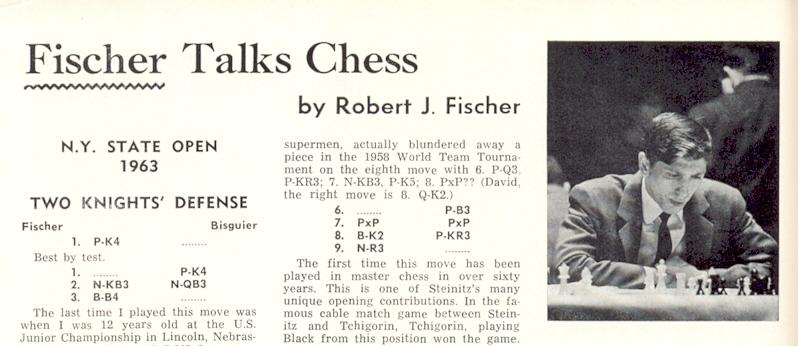
That was also the game in which Fischer discussed and corrected analysis of a Steinitz v Chigorin game which had been given on page 77 of the March 1892 Deutsche Schachzeitung, and for readers who wish to compare the two sets of comments (as well as what appeared in My 60 Memorable Games) we reproduce below the relevant passage from page 302 of the December 1963 Chess Life and the note in the Deutsche Schachzeitung:

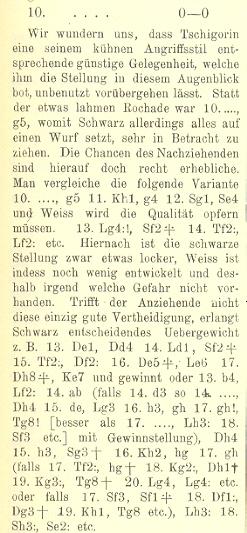
It may be noted that in the penultimate paragraph in Chess Life the pawn exchange given by von Gottschall was omitted, so that Fischer had ...Rg8 at move 16, instead of move 17. Those moves were, however, given accurately in My 60 Memorable Games.
On pages 215-216 of the September 1963 issue Fischer annotated his game against Hans Berliner in that year’s Western Open (‘a model of a tournament compared to some of the foreign ones I’ve been in’). That game is not in his book, even though the closing note in Chess Life reads:
‘It is difficult to find one particular game that is typical of my “style”. This comes close.’
His penchant for taking readers by surprise was shown by his first note to a further game from the same column and the same event, Reinhard v Fischer, which began 1 Nf3 Nf6 2 g3 g6 3 Bg2 Bg7 4 O-O O-O 5 d3 d6:
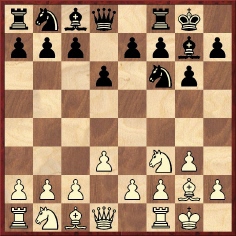
Before looking at Fischer’s assessment of this position, readers are invited to make their own. Is it level? Despite the symmetry, does White retain the advantage of the first move? Not according to Fischer:
‘“Believe it or not”, Black stands better! Now whatever White does, Black will vary it and get an asymmetrical position and have the superior position due to his better pawn structure! In the Filip – Fischer game, Varna, 1962, similarly Black gets the upper hand: 1 d4 Nf6 2 c4 g6 3 g3 c6 4 Bg2 d5 5 cxd5 cxd5 6 Nf3 Bg7 7 O-O O-O 8 Nc3 ...; and Black, breaking the symmetry at the proper time, gets the advantage by 8...Ne4.’
On page 236 of the October 1963 Chess Life (annotating his game against R. Oster at the New York State Open) he wrote that after 1 d4 Nf6 the move 2 Nf3 is ‘a rather common mistake’. For an account of Fischer’s controversial discussion of the Grünfeld Defence on pages 237-238 of the same issue, see pages 146-147 of Chess Facts and Fables.
Finally here, on page 198 of the July-August 1963 Chess Life Fischer explained what had happened in his famous loss (12...h5) to Unzicker:
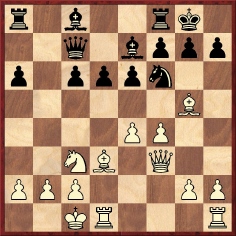
‘In this position, at Buenos Aires, 1960, Unzicker played against me 12 Qg3. I hope that none of my readers will make the move that I did in reply: 12...h5. I touched the pawn, intending ...h6 – and noticed, just in time, that White could play Bxh6. So I had to play the meaningless ...h5, which weakened my king-side and I eventually lost.
Against Unzicker’s 12 Qg3 the correct reply is 12...e5, with the better game for Black. If 13 fxe5 dxe5 14 Bc4 Nh5 15 Qh4 Bxg5+ 16 Qxg5 Nf4 and Black stands better.’
In the passages quoted above, the moves have been converted to the algebraic notation.
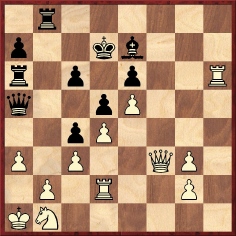
This position (White to move) appeared on page 42 of Bobby Fischer’s Games of Chess (London, 1959), having arisen in his encounter with Mednis in the 1957-58 US championship. Fischer won quickly with 32 Rxe6 and commented:
‘The position is a paradox. Black has poised all of his pieces for attack, and White has placed almost all of his pieces for defense; and yet White has a winning attack. The reason for this is that Black’s king is unprotected except for his KB, and White is actually attacking with three heavy pieces.’
Are there any better examples of paradoxical positions?
 From page 14
of R.D. Yates Checker Player by W.T. Call (New York,
1905):
From page 14
of R.D. Yates Checker Player by W.T. Call (New York,
1905):
‘Paul Morphy, the chess genius, sought to obtain a glimpse into the scientific depths of checkers without too much trouble, but never succeeded in getting within sight of anything under the surface of the game. When he went to England he asked Thomas Lear, who played both checkers and chess, to explain to him “wherein the beauty of draughts playing lay”. On another occasion, half in jest, half in earnest, the great chess master said to a New York player, “Checkers is for tramps”.
W.J.A. Fuller, chess editor of Leslie’s Illustrated Newspaper, declared that checkers is “all bosh”, although he was what the checker editor of the New York Clipper called “a bold, dashing and original draughts player”. Hodges, the Buffalo expert, was beating Fuller at checkers repeatedly, to the great satisfaction of the bystanders, when the author of the “all bosh” remark claimed he had an easy draw, and his offer to make a bet and give odds on it was quickly taken. Fuller won the bet by gently drawing his knees apart and allowing the board and men to fall to the floor. This, by the way, is the origin of “Fuller’s draw”, a phrase sometimes used to describe the only thing an inferior player might expect to get from an adept.’
Wanted: substantiation of the foregoing, and particularly the material about Morphy.
The illustration came from page 111 of the February 1946 CHESS, where John Butterworth presented his system for drawing chess pieces in diagrams:
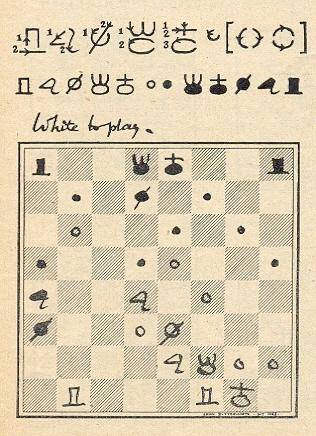

Avital Pilpel (Haifa, Israel) mentions that Tarrasch in the painting (top left-hand corner) has clearly been based on the photograph of him which was given on page 183 of Chess Facts and Fables:
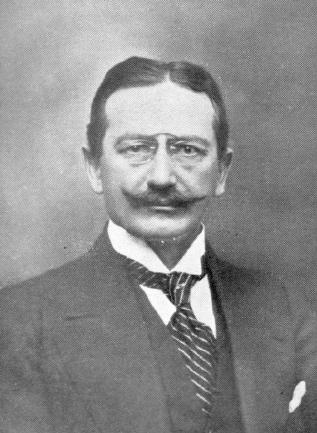
We gleaned it from the special Tarrasch issue of Kagans Neueste Schachnachrichten, 1922, although it evidently dates from many years earlier. The following shot was published opposite page 161 of La Stratégie, May 1913:
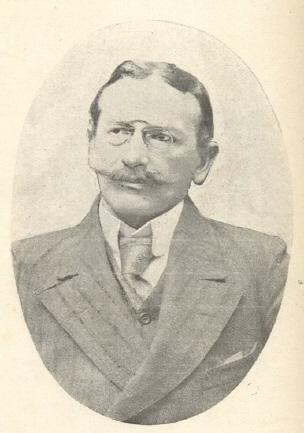
Michael Macdonald-Ross (Wheathampstead, England) comments that the portrayal of Tarrasch in the painting suggests the early 1900s, which would explain the absence of Capablanca, Rubinstein and Alekhine, although he is surprised not to find Teichmann or Pillsbury. He also suggests that since Blackburne wore a goatee he may be the figure in the bowler hat.
In a sequence of issues of the 1942 BCM T.R. Dawson dealt with ‘Problem themes in play’. Michael McDowell (Westcliff-on-sea, England) writes:
‘I think the most intriguing example given is von Holzhausen v Wiegand (No. 61 from page 127 of the June 1942 magazine), which shows the Wurzburg-Plachutta theme, a Plachutta without the initial sacrifice on the interference square. For such an idea to turn up in a game is truly astonishing. So many pieces just happen to be on the right squares for it to work. I wonder if it is possible to trace the game-score. The 1943 book Problemkunsten og det praktiske spil by Poul Hage gives the source as Magdeburg, 1921.’

C.N. 4424 reminded Mr McDowell of a note by Michael Stean on page 508 of the November 1977 BCM in his victory as Black over Yochanan Afek in that year’s Aaronson Congress in Harrow:

‘One of the strangest positions I have ever met in my playing career. Black is the exchange down with two bishops hiding on the edge, a rook decaying in the corner, his king stuck in the middle of nowhere, the queen being his only active piece. Admittedly White also has a rook under suspension but his other three pieces in active service are strangely unable to make any impact. In fact it is Black who stands better and it is even possible he is winning by force.’
The complete game-score is: 1 e4 c5 2 c3 e6 3 d4 d5 4 e5 Qb6 5 Nf3 Bd7 6 a4 Nc6 7 Be2 cxd4 8 cxd4 Nge7 9 Na3 Nf5 10 Nc2 Bb4+ 11 Kf1 Be7 12 g4 Nh4 13 Nxh4 Bxh4 14 g5 h6 15 gxh6 g5 16 b4 Rxh6 17 b5 Na5 18 Ne3 f5 19 exf6 Rxf6 20 Bh5+ Kd8 21 Ng4 Rf5 22 Bg6 Nc4 23 Bxf5 exf5 24 Ne3 f4 25 Nxc4 Bh3+ 26 Kg1 dxc4 27 Ra3 Qe6 28 d5 Qf5 29 Rxh3 Qxh3 30 Qd4 Rc8 31 Qf6+ Kc7 32 Qe5+ Kb6 33 Qd6+ Ka5 34 Ba3 Qc3 35 Kg2 f3+ 36 Kh3 Bxf2 37 Rb1 Rh8+ 38 Kg4 Rh4+ 39 Kxg5 Qg7+ 40 Kf5 Qf7+ 41 White resigns.
Further to C.N. 4416, which has now blossomed into a feature article, Yakov Zusmanovich (Pleasanton, CA, USA) refers to a work which he used to possess, Capablanca i Alekhine by E.A. Znosko-Borovsky (Paris, 1927, in Russian). ‘The book was brought out by Znosko-Borovsky just a month before the Capablanca v Alekhine match in Buenos Aires. It contains biographies of both masters and several of their best games.’
We recall that the book (which we have never seen) was mentioned in the entry on Znosko-Borovsky on page 312 of An illustrated Dictionary of Chess by Edward R. Brace (London, 1977), after which a reader of CHESS (August 1978 issue, page 353) queried whether it existed. It is, however, listed in the Cleveland Library, as follows:
‘Kapablanka i Alekhin: bor’ba za mirovoe pervenstvo v shakhmaty / Evg. A. Znosko-Borovskiĭ.
Parizh: Société “N.P. Karbasnikoff”, 1927.
Item Description: 128 p. : ill. ; 20 cm.’
Leonard Skinner (Cowbridge, Wales) has sent us a photocopy of what appears to be the first monograph about Alekhine, Geniy Kombinatsiy Grossmeister A. A. Alekhin by A. Mirles (Kiev, 1926). It is 56 pages long and has notes to well-known specimens of Alekhine’s play, together with a 16-page biography.
As regards books by Alekhine himself, we compiled the following list in C.N. 1709:
1) Das Schachleben in Sowjet-Russland (1921)
2) The Book of the Hastings International Masters’ Chess Tournament 1922 (1924)
3) The Book of the New York International Chess Tournament 1924 (1925)
4) La valeur théorique du Tournoi de Baden Baden (1925)
5) De schaakwedstrijd Aljechin-Euwe (with Euwe) (1927)
6) My Best Games of Chess 1908-1923 (1927)
7) Das New Yorker Schach Turnier 1927 (1928)
8) Auf dem Wege zur Weltmeisterschaft (1932)
9) 66 Master Games Played in the London International Chess Tournament, 1932 (1932)
10) Internationales und 37 Schweizerisches Schachturnier in Zürich 1934 (1935)
11) Alekhine-Euwe 1935 (in Dutch, with Euwe) (1936)
12) The Book of the Nottingham International Chess Tournament 1936 (1937)
13) The World’s Chess Championship 1937 (with Euwe) (1938)
14) My Best Games of Chess 1924-1937 (1939)
15) Gran Torneo Internacional de Ajedrez, Madrid 1943 (1944)
16) ¡Legado! (1946)
17) Gran Ajedrez (1947).
C.N. 1709 mentioned that Das Erste Internationale Schachmeisterturnier in Kecskemét 1927 (1928) was not included as it featured Alekhine’s notes to a small number of games. Similarly, although Alekhine ‘directed’ Ajedrez Hipermoderno (1945) he annotated only a few games. The list also excluded the modern compilation 107 Great Chess Battles, and the C.N. item ended by pointing out that Alekhine wrote no books in his mother tongue, Russian.
As shown below, the front cover of his first book gave a curious rendering of his name: A. v. Alchechin:
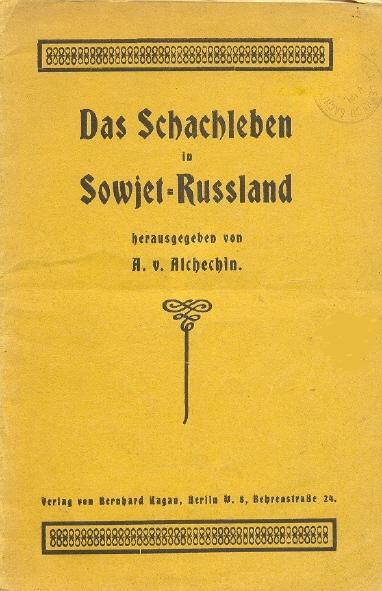
From Stephen Wright (Vancouver, Canada):
‘I cannot positively identify the source of “chessicide”, but I strongly suspect that it is in the tournament book produced by Abe Yanofsky. The 1st Canadian Open was reported on in the August-October 1956 (combined) issue of Canadian Chess Chat, pages 8-14, in an article by Yanofsky, who had just taken over as editor of the magazine. The introductory text in this article is identical to the first two italicized paragraphs on the website of the Fédération québécoise des échecs. The rest of the Canadian Chess Chat article (covering the individual rounds) is shorter than, and different from, the text on the website, but there is mention that a tournament book, to contain the hundred best games, was in preparation.’
This game was published on page 90 (misnumbered 80) of the Chess Player’s Chronicle, 20 August 1884, being taken from the New York Clipper:
Preston Ware, Jr. – F.J. Keyes1 f3 f6 2 e3 e6 3 c3 c6 4 d4 d5 5 Bd3 Bd6 6 f4 f5 7 Nf3 c5 8 O-O c4 9 Bc2 Nf6 10 Ne5 O-O 11 Nd2 Nc6 12 Ndf3 Qe8 13 Bd2 Ne4 14 Be1 h6 15 g4 fxg4 16 Nxg4 Qg6 17 Nfe5 Nxe5 18 dxe5 Bc5 19 Qf3 h5 20 h3 hxg4 21 Qxg4 Qf5 22 Kh2 Bd7 23 Qf3 Ng5 24 Qg2 Ne4 25 Rf3 Be8 26 Rg3
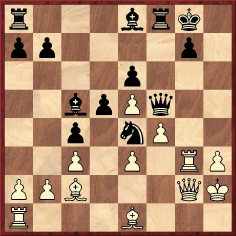
26...Nxg3 27 Bxf5 Nxf5 28 e4 Ne3 29 Qf3 dxe4 30 Qxe4 Bc6 31 Qg6 Nf1 mate.
Alan McGowan (Waterloo, Canada) points out that Irving Chernev also mentioned Anderson on page 6 of his book The Compleat Draughts Player (Oxford, 1981):
‘Andrew Anderson was the first man to be recognized as World Champion, by virtue of his victory over James Wyllie in 1847 in a match for the title. He scored nine wins to six losses, with 31 games drawn.
On his retirement, the title passed to Wyllie, who held it on and off for 40-odd years.’
Before quoting a reader’s contribution, we supply the context by reproducing C.N. 2250.
Modern books record that the word Benoni comes from the Hebrew for ‘child/son of (my) sorrow/sadness’.
Page 318 of The Chess-Player’s Companion by Staunton implied that Benoni had been somebody’s name: ‘M. St Amant derived this somewhat bizarre defence from Benoni. (Benoni, oder [die] Vertheidigungen [gegen] die Gambitzüge im Schache, etc. Von Aaron Reinganum, Frankfort, 1825)’ was the note after 1 d4 c5 2 d5 f5. R. Rey Ardid was even more specific (about 1 d4 c5) on page 22 of Cien nuevas partidas de ajedrez (Saragossa, 1940): ‘An old, audacious defence which comes from the English player Benoni (1825)’. Presenting the game Petrosian v Schmid in his book L’intuition à l’affût, A. O’Kelly noted the Hebrew meaning but claimed that around the 1830s there were two brothers named Benoni who had regularly played the opening. O’Kelly further remarked that during a visit to South Africa he had been surprised to find a town named Benoni in the Johannesburg area. We add that there is also a place called Benoni in Malaysia.
See too an item by that fine chess historian Frank Skoff in the September 1968 issue of the Illinois Chess Bulletin, reprinted on pages 56-57 of the February 1969 BCM.
Avital Pilpel (Haifa, Israel) now writes:
‘In the Hebrew-language book Taharut Amanim be’Sachmat: Yerushalayim-Tel Aviv-Haifa, 1952 (Chess Masters’ Tournament, Jerusalem, Tel Aviv and Haifa, 1952) by R. Persitz and A.A. Mendelbaum (Tel Aviv, 1953) the Hebrew name given (on page 15) is the “Ben-Oni” Defense, which literally means “son of my strength”. Figuratively, it may also mean “son of my loins” or “son of my virility”. The word “On” (“strength”) often means virility, or the ability to beget children (as opposed to impotence or sterility).
The Hebrew spelling definitely excludes here the possibility of either “son of sorrow” or “son of my sorrow”.
More recent Hebrew-language works spell “Benoni” phonetically, without any hyphens or spaces, in a way that has no particular meaning in Hebrew.
“Son of sorrow” (or poverty) in Hebrew would be the closest pronunciation match with “Benoni”, as it is pronounced ben-Oni (with stress on the O), as opposed to “son of my strength” (ben-o NI) or “son of my sorrow” (ben-on’YI).’
From Dan Scoones (Victoria, BC, Canada):
‘Regarding Alekhine’s two-volume set in English entitled My Best Games of Chess, for many years I assumed that the books had originally been published in French, not least because of the existence of a two-volume set under Alekhine’s name, Deux cents parties d’échecs, but those volumes correspond to the first My Best Games of Chess book and to another work by Alekhine, Auf dem Wege zur Weltmeisterschaft. There are two questions of interest:
1. Were Alekhine’s two Best Games volumes translated from an unpublished manuscript?
2. Does Deux cents parties d’échecs contain some of the original manuscript, or is the whole thing a retranslation from English?’
The matters raised by our correspondent are not clear-cut, but we offer some pointers:
The first volume of My Best Games of Chess (London, 1927) stated that it was ‘translated from the original MSS (in French) by J. du Mont and M.E. Goldstein’. For an illustration of that title page, see C.N. 4310.
The second volume (London, 1939) contained no mention of any translator:
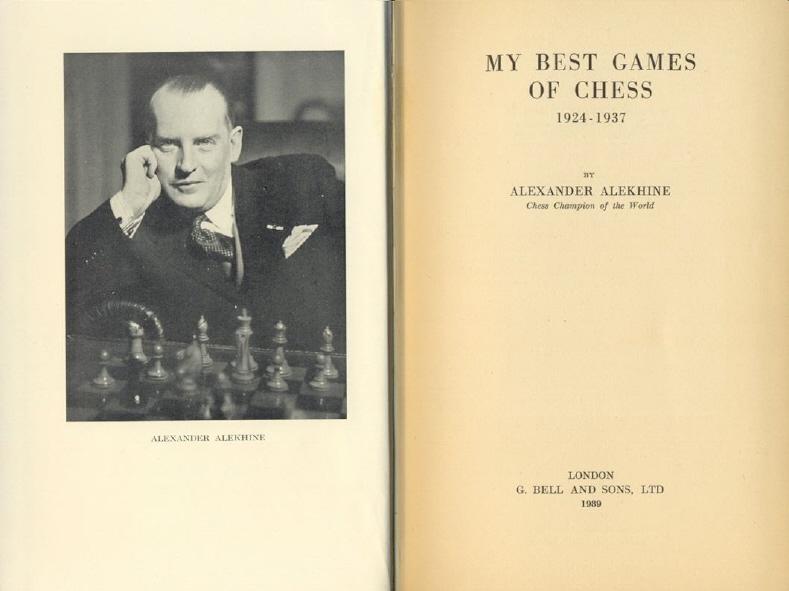
The only acknowledgment (deleted later on) for another party’s involvement in the book was on the imprint page:
‘The Author is indebted to Mr E.R. Cordingley for his valuable assistance in reading the proofs.’
In 1947, the year after Alekhine’s death, this second volume of Best Games was re-issued with a memoir by Julius du Mont (which made no reference to any translation involvement by himself). However, the obituary of du Mont by D.J. Morgan on pages 119-120 of the May 1956 BCM stated that du Mont had translated ‘Alekhine’s two volumes of My Best Games of Chess (the first with M.E. Goldstein)’.
That is certainly the common view, but is the reference to the second volume correct? It may be relevant to note a letter contributed by du Mont on page 173 of the May 1946 CHESS:
‘There is one aspect of Dr Alekhine’s character which may come as a surprise to chessplayers generally, for in that respect he has not been very advertised, that of kindliness and readiness to help.
In 1938 I happened to meet Dr Alekhine and his wife in the Strand Palace Hotel [in London] and he asked me to sit at their table. I had not met him or corresponded with him for some years, not since I translated his first book for a very substantial fee. I was neither wealthy nor influential, nor was I the editor of a chess publication. I was carrying in my hand the proofs of my Basis of Combination in Chess. Dr Alekhine asked me what it was and I said it would not interest him, but he insisted that everything interested him and he took a very long time glancing through the proofs. In the end he said: “I like the idea very much. Would you like me to read the proofs for you and to check the analysis?” I was dumbfounded and suitably expressed by appreciation. Some ten days later the proofs came back corrected, and in two places some valuable additions were made to the analysis. A charming little note accompanied the package with encouraging words of appreciation and enclosing another letter which Dr Alekhine said I could use in any way I wished, and which the publisher did in fact use on the blurb of the book when it came out.
As a contrast I may say that the first man I met who had read Dr Alekhine’s comments on the blurb asked me, “What did that cost you?” I avoided being ungentle by not answering.’
Alekhine was in London in January 1938 (C.N. 3817 discussed his game that month against Elaine Saunders), but du Mont’s account makes no mention of any arrangement to translate Alekhine’s second volume of Best Games (which was published on 18 October 1939, as reported on the inside front cover of CHESS, November 1939). Are there thus grounds for believing that du Mont was not the translator (in which case, who was?), or did du Mont provide confirmation elsewhere that he did indeed translate it? In either case, why was no translator named in the book?
A further consideration about du Mont is that in the late 1930s he was preparing, jointly with Tartakower, the 665-page book 500 Master Games of Chess. Although it was not published until 1952, the manuscript was delivered in 1939 (see the BCM, April 1952, page 105 and May 1952, page 133). It would be exceptional if, in 1938-39, du Mont were able to work concurrently on both that huge project and a translation of the Alekhine book, quite apart from finalizing in 1938 The Basis of Combination in Chess.
Deux cents parties d’échecs was published in Rouen in 1936 (in a single volume) by the French Chess Federation, which stated in an introductory note that Alekhine had generously provided the material:
‘Un geste généreux du grand Champion A. Alekhine nous a permis d’enrichir la littérature échiquéenne française d’un document inestimable, d’un choix unique de chefs-d’oeuvre.’
Pages xvii-xxiv carried a Preface by Alekhine dated September
1936, but we see no relevant information about the genesis of
the collection, which was the first appearance of Alekhine’s
best games in French.
The book was reprinted in two volumes by the BCM in 1973 and 1979 respectively and was re-issued by Bernard Grasset, Paris, also in two volumes, in 1999 and 2000. Broadly speaking, the first volume corresponds to My Best Games of Chess 1908-1923 and the second to Alekhine’s 1932 book Auf dem Wege zur Weltmeisterschaft. As far as we know, Alekhine’s second volume of Best Games has never, to this day, appeared in French.
C.J. Feather’s English translation of Auf dem Wege zur Weltmeisterschaft was published by Pergamon Press in 1984 under the title On the Road to the World Championship 1923-1927.
The above jottings are not, alas, direct answers to our correspondent’s questions about the manuscripts of Alekhine’s books, as we are still at the stage of laying the groundwork. Readers are invited to help us pursue the matter, and not least on the basis of the works’ contents. Do comparisons between various editions yield any clues?
From Pierre Bourget (Beauport, Canada):
‘Tartakower’s My Best Games of Chess 1931-1954 was translated from French by Golombek, but I have never seen a book in French by Tartakower for that second period. I am aware of a French edition only for 1905-1930, under the title Tartacover vous parle.’
Tartacover vous parle was published by Librairie Stock, Paris in 1953 and is readily available today, having been re-issued by Payot, Paris in 1992. In common with our correspondent, we have no knowledge of a French edition on the years 1931-54.
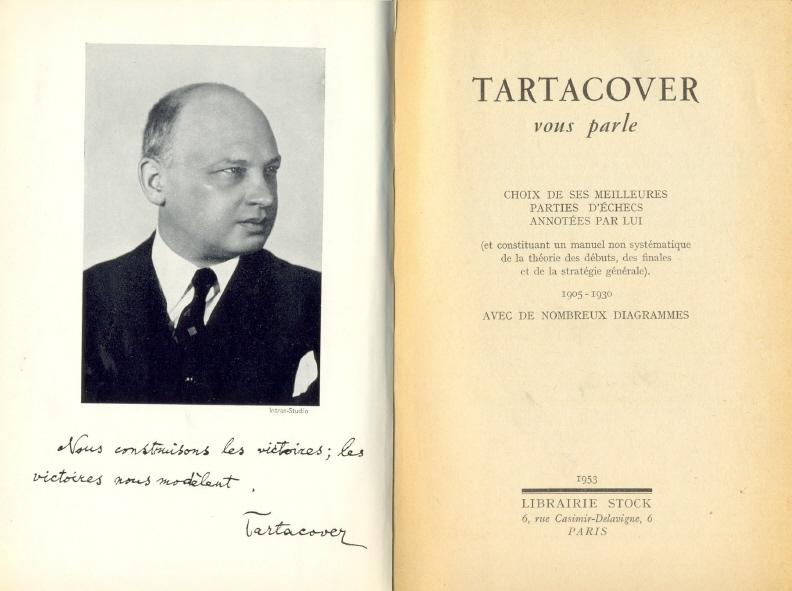
Some further remarks may be added here. My Best Games of Chess 1905-1930 and Tartacover vous parle are not identical. Most notably, the French book had four additional Tartakower games, against Alapin (Munich, 1909), Wolf (Vienna, 1922), Golmayo (Barcelona, 1929) and Font (Barcelona, 1929).
Tartakower is one of the most difficult chess writers to translate into English (among others are A. Nimzowitsch and F.K. Young), but on one relatively straightforward matter Golombek seems to have gone astray. It concerns the conclusion of Tartakower v Rubinstein, The Hague, 1921. The English edition (page 96) reads:
‘In his obstinate search for a saving clause Black here exceeded the time limit, but play continued, and White’s victory was achieved without taking notice of this disagreeable circumstance in the following way: ...’
The idea that play went on after Rubinstein’s flag had fallen is strange, and Tartacover vous parle (page 139) has something altogether different:
‘Dans la recherche obstinée d’un sauvetage, les Noirs dépassèrent ici le temps de réflexion, mais la victoire des Blancs s’obtenait même sans cette circonstance fâcheuse de la façon suivante: ...’
There is nothing about ‘play continued’ in the French version. A revised English translation would read:
‘In his obstinate search for a saving clause, Black here exceeded the time limit, but even without that disagreeable circumstance White would win, as follows: ...’
Golombek appears to have misunderstood ‘s’obtenait’ and to have set off down a wrong path which prompted him to add the words ‘play continued’.
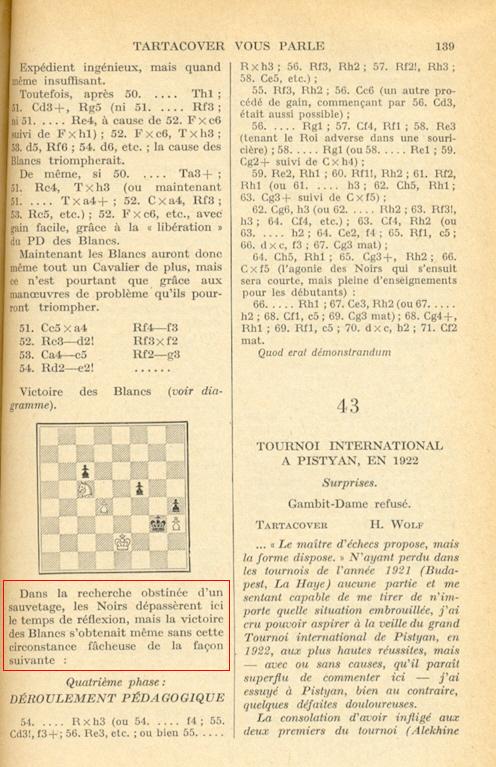
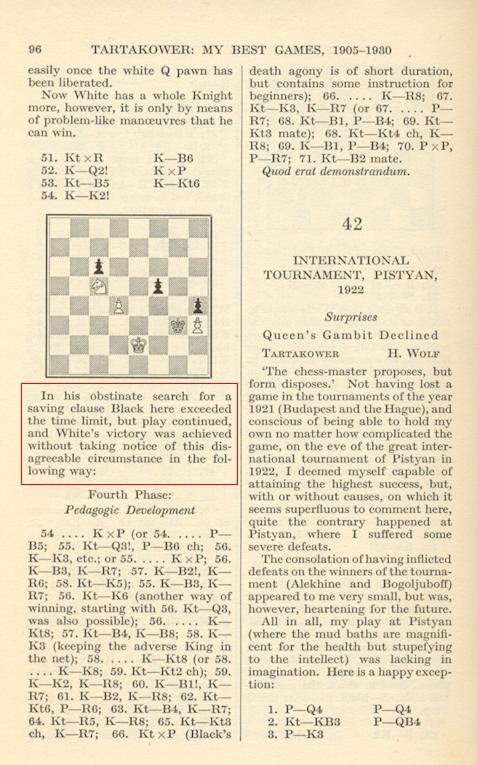
However, one complication still needs to be considered. There exists a German translation, by Rudolf Teschner, of Tartakower’s book, under the title Tartakowers Glanzpartien, 1905-1930. Since it specifically billed itself as a translation from the French original, it would hardly be expected to follow the Golombek version rather than what appeared in Tartacover vous parle, yet it did exactly that:
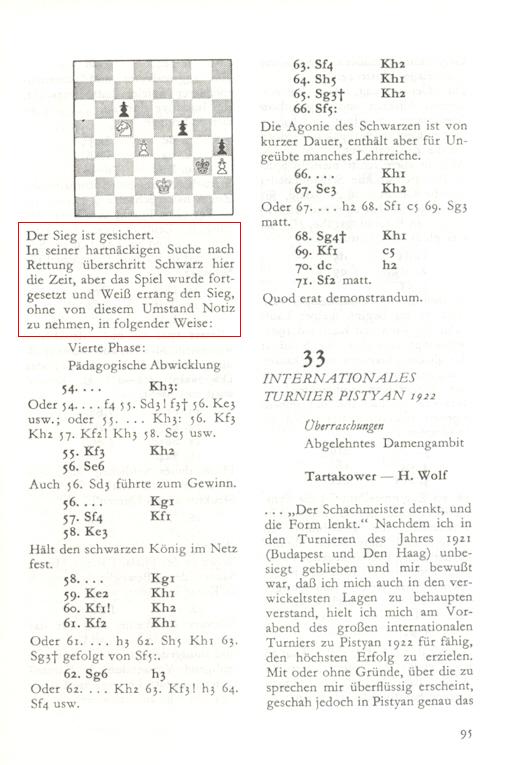
We have found no contemporary (1921) source which suggests that the game continued to 71 Nf2 mate. On page 461 of the December 1921 BCM Sir George Thomas wrote after 53...Kg3, ‘At this stage, Black lost by over-stepping his time-limit. The game could not be saved in any case. A likely continuation would be 54 Ke2 ...’, after which he gave some 20 lines of analysis. See also page 25 of the tournament book by B. Kagan, page 215 of Schachjahrbuch 1921 by L. Bachmann (Ansbach, 1923), page 43 of 500 Master Games of Chess by S. Tartakower and J. du Mont (London, 1952), page 9 of the tournament book by A. Becker and page 19 of Akiba Rubinstein: The Later Years by J. Donaldson and N. Minev (Seattle, 1995).
C.N. 3377 (see page 304 of Chess Facts and Fables) mentioned that on page 65 of Tartakower’s book Ideas modernas en las aperturas de ajedrez (of which we have the fifth edition, published in Buenos Aires in 1967) he mysteriously referred to 1 e4 Nf6 2 Nc3 as the ‘Variante del Yatagán’.
We note that on page 34 of Tartacover vous parle (Paris, 1953) he wrote the following after the moves 1 e4 e5 2 Nc3 Nf6 3 Bc4 Nxe4 4 Qh5 Nd6 5 Bb3 (in his game against Spielmann, Ostend, 1907):
‘Continuant le combat “à yatagans”, tandis que l’autre suite possible 5 Dxe5+ De7 6 Dxe7+ Fxe7, etc. aplanit trop le champ de bataille.’
Yatagan, a curved Turkish sword, conjures up an image of hacking and hewing. Golombek’s translation of the relevant part of the note (see page 19 of My Best Games of Chess 1905-1930) was: ‘Preferring to continue the combat in razor-sharp style ...’
Regarding the manuscript of Alekhine’s first volume of Best Games (also mentioned by D.J. Morgan in C.N. 4204), Gene Gnandt (Houston, TX, USA) quotes from the reminiscences of Brian Reilly in an interview on page 353 of the September 1981 BCM. W.H. Cozens asked him about Alekhine’s occasional presence in Nice, where the young Reilly had lived:
‘I first met Alekhine in July 1923, in Paris during the first National Championship organized by the newly formed French Chess Federation. I had accompanied Renaud as his second. Somewhat to his own surprise he won the title, half a point ahead of the favourite, A. Muffang. Alekhine was one of the onlookers. He came over to congratulate his old friend Renaud and added, with a twinkle: “And now, Georges, there is only one more thing for you to do: that is, learn how to play!”
A few months later Alekhine came to Nice, bringing the manuscript of his My Best Games 1908-1923 with the object of having the French text checked by Renaud. (I should add that Alekhine had virtually three mother tongues – Russian, German and French. He had learnt French from a French governess and spoke it like a native, but his schooling had been in Russian.) Every afternoon he and Renaud arrived at the club where they played through the games with a small band of young players eagerly listening to Alekhine’s comments. We soon started asking questions and making suggestions, most of which were refuted out of hand; occasionally Alekhine did agree to add a variation or a few words of clarification. It is not often that an author has occasion to show his work before publication like this.’
There is a discrepancy over the exact chronology, as the Skinner/Verhoeven book on Alekhine (pages 187-188) contains a blindfold victory over Reilly in Nice on 27 March 1923, i.e. a few months before the French championship, but the substantive point is that already that year the original French manuscript was well under way, if not virtually finalized. In which language or languages Alekhine was expecting publication is not known. The first edition was My Best Games of Chess 1908-1923, brought out by G. Bell in summer 1927. As noted in C.N. 4436, the book did not appear in French until 1936.
Mr Gnandt notes that the interview with Brian Reilly is available on-line.
C.N. 4296 gave an 1852 contest played at the summit of Ben Lomond. On the same theme, a correspondence game on pages 71-72 of the December 1914 Chess Amateur was introduced as follows:
A.C. Vernieux – V.S. Date‘The winner, writing from Darjeeling, August 1914, says that this is a record game in respect of the circumstances in which it was played.
“It accompanied me throughout my tours on duty, and even when I went to Tibet. A few moves were by telegraph, and one of these was sent from a telegraph office at a height of 14,300 feet – not much below Mt Blanc ...”’
1 e4 e5 2 f4 d5 3 exd5 e4 4 Bc4 c6 5 Nc3 Nf6 6 dxc6 Nxc6 7 d3 Bg4 8 Nge2 Bb4 9 h3 Bxc3+ 10 bxc3 Bf5 11 Ng3 Qa5 12 Rb1 Bc8 13 Rb3 exd3 14 cxd3 O-O 15 O-O a6 16 Qf3 Qc7 17 Ne4 Qd8 18 Ba3 Nxe4 19 dxe4 Na5 20 Rb4 Nxc4 21 Rxc4 Re8 22 e5 Be6 23 Rd4 Qa5 24 c4 b5 25 c5 Bxa2 26 f5 Bc4
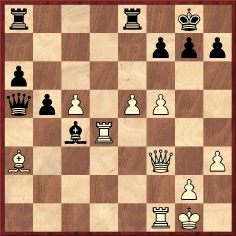
27 e6 Rad8 28 Rg4 Qc7 29 Rxg7+ Resigns.
Alekhine’s involvement in The Basis of Combination in Chess by J. du Mont was mentioned in C.N. 4436; du Mont reported that Alekhine had given him a text which ‘I could use in any way I wished, and which the publisher did in fact use on the blurb of the book when it came out’.
George Routledge & Sons, Ltd. certainly made the most of Alekhine’s encomium, emblazoning part of it on the front dust-jacket:
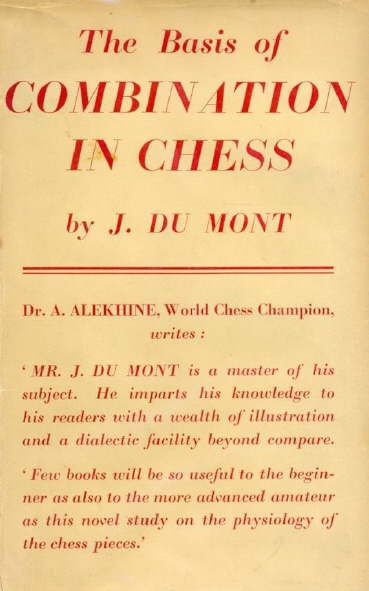
The front-jacket flap had the full version:
‘The Basis of Combination in Chess
From Dr Alekhine, Chess Champion of the World
It is principally by learning to know and to appreciate the pieces from this point of view – marvelling at their powers and pitying them in their weaknesses (poor isolated pawns, poor pinned rooks and knights) – that it is possible to become an efficient director of the tragi-comedies which are played on the 64 squares.
Mr J. du Mont has carefully studied his flock, composed of such varied elements. He is a master of his subject. He knows the teams which work well together (e.g. the two bishops) and those which do not get on so well (e.g. two knights which cannot effect a mate), the units which are in absolute need of the assistance of their companions (as the united pawns) and those which of their own power are often able to work miracles (the queens in Q endings, the king in pawn endings). He knows all this and imparts his knowledge to his readers with a wealth of illustration and a dialectic facility beyond compare.
Few books will be so useful to the beginner as also to the more advanced amateur as this novel study on the physiology of the chess pieces.’
A shorter text by Tartakower appeared on the back-jacket flap:
‘A great expert and a great teacher, Mr J. du Mont, in this book, gets very near to the ideal of instructing and entertaining at the same time.
Profound ideas, emitted without insistence, without preaching, smilingly, making light of the difficulties of the subject, in passing, strolling along, but always moving forward hand in hand with the intrigued reader towards the ultimate aim: to improve, enrich and deepen his game.’
John Donaldson (Berkeley, CA, USA) writes:
‘Frank Ross Anderson (1928-80) was a two-time gold medalist on board two for Canada, in the 1954 and 1958 Olympiads in Amsterdam and Munich, and received the International Master title for his result in Amsterdam.
Contemporaries to whom I have spoken and recent articles in Canadian publications have said that Anderson would have received the Grandmaster title for his performance in Munich except that he did not play his last game; he had gained the necessary number of points but had not played the necessary number of games. Today, FIDE allows a norm-seeker to take a loss on paper in such situations, but this seems not to have been the case in the past.
It is stated regarding the last round in Munich that Anderson was extremely ill and unable to play, and I have been able to confirm this from contemporary newspaper accounts and correspondence with Ross Siemms, one of his team-mates in that Olympiad. Anderson, who was bed-ridden for much of his youth with a serious form of arthritis, developed influenza during the last rounds of the Olympiad but kept playing up to and including the penultimate round. Canada was in a battle for first place in the B group.
The Toronto Telegram of 15 October 1958, page 13, stated that the Russian team doctor was not called on during the Olympiad until Anderson, his hotel neighbor, went down with influenza. The doctor stepped in and looked after him. Anderson therefore missed the final round, “... but, I was glad he was around”, he remarked about the doctor in a letter to Fred W. Walton, the chess writer in the Telegram. “He was very good.”
Had Anderson been awarded the Grandmaster title after the Munich Olympiad, he would have been the Commonwealth’s first recipient of it on the basis of over-the-board scores, some six years before Yanofsky at Tel Aviv, 1964. Can any reader shed light on the situation concerning Anderson and the prospective Grandmaster title in 1958 and on what FIDE’s requirements for the title were at that time?’
Who is this national champion, who played games against Lasker, Capablanca and Alekhine?

Chess Notes Archives:
| First column | << previous | Archives [23] | next >> | Current column |
Copyright 2006 Edward Winter. All rights reserved.